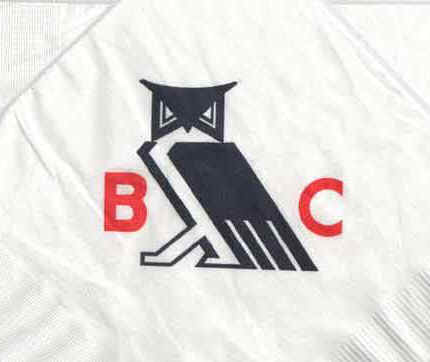
Bohemian Club
Why do the Authorities Still Allow this Club to Operate?
updated 1-2-14

Social Cohesion & the
|
|||||||||||||||||||||||||||||||||||||||||||||||||||||||||||||||||||||||||||||||||||||||||||||||||||||||||||||||||||||||||||||||||||||||||||||||||||||||||||||||||||||||||||||||||||||
 |
The Bohemian Grove is a 2,700-acre virgin redwood grove in Northern California, 75 miles north of San Francisco (map), where the rich, the powerful, and their entourage visit with each other during the last two weeks of July while camping out in cabins and tents.
It's an Elks Club for the rich; a fraternity party in the woods; a boy scout camp for old guys, complete with an initiation ceremony and a totem animal, the owl. It's owned by the Bohemian Club, which was founded in San Francisco in 1872. The Bohemians started going on their little retreat shortly after the club was founded; it became big-time by the 1880s, and it continues today.
However, it is not a place of power. It's a place where the powerful relax, enjoy each other's company, and get to know some of the artists, entertainers, and professors who are included to give the occasion a thin veneer of cultural and intellectual pretension. Despite the suspicions of many on the Right, and a few on the Left, it is not a secret meeting place to plot, plan, or conspire. The most important decisions typically happen just where we might expect: in the boardrooms of corporations and foundations, at the White House, and in the backrooms of Congress. Yes, as I show later, some wanna-be and has-been Republican politicians sometimes visit the Bohemian Grove, including future and former presidents of the United States, but they are there to demonstrate what wonderful human beings they are, to cultivate potential financial backers, or to brag about their past exploits.
Readers who suspect that every gathering of the rich and the powerful has some deeper purpose may doubt this claim, at least until they see my evidence. For those who still might question my conclusions after reading this article, I recommend reading an excellent first-hand account of the Bohemian Grove by a journalist from Spy magazine who snuck into the encampment in 1989; the author had every incentive to tell it exactly as he saw it. More recently, a reporter from Vanity Fair snuck into the Grove during the 2008 encampment to investigate logging activity as well as the usual goings-on, and his experiences are summarized in a May 2009 article entitled "Bohemian Tragedy."
In fact, every person who has written seriously on the Bohemian Grove agrees: even though they provide evidence that there is a socially cohesive upper class in the United States, the activities at the Grove are harmless. The Grove encampment is a bunch of guys kidding around, drinking with their buddies, and trying to relive their youth, and often acting very silly. These activities do contribute to social cohesion as an unintended consequence -- which is why I decided to study the Bohemians in the first place -- but the Grove is merely a playground for the powerful and their entertainers that gives us a window into a lifestyle that is far removed from that of average Americans.
If this is a web site about power, politics, and social change, why bother with the Bohemian Grove if it is not a place of power?
That's a fair question, and an important one in terms of differentiating rival theories of power in the United States. The answer goes back to the kind of criticisms that used to be made of a class-domination theory by the most important group of theorists in the social sciences during the 20th century, the pluralists. Pluralists deride the idea that there could be class domination in the United States, and one of the reasons they do is that the upper class of rich people is allegedly too fragmented to be able to organize for power. Heck fire, them rich people don't even know each other, most of 'em. All those wealthy capitalists that theorists like me talk about are just a list of names, not a for-real social class.
So I was looking for an opportunity to show pluralists differently when I unexpectedly noticed that a wealthy liberal lawyer I was about to interview in late 1970 about campaign finance -- you know, the kind of stuff I should be studying -- had the membership lists for the Bohemian Club and the even more exclusive Pacific Union Club on a shelf in his waiting room. We hit it off well during the interview, and he clearly liked to stir things up, so I asked him if I could photocopy the lists. He said "sure." and I was off and running. Those two membership lists gave me the starting point for a study that would allow me to trace the social backgrounds and corporate connections of men who slept together in cabins and tents in the California redwoods, so I figured you couldn't get more "socially cohesive" than that.
Moreover, there is a literature in social psychology, called small-group research, or small-group dynamics, which shows that people who meet in relaxed settings, and see their group as exclusive, become even tighter with each other than people in ordinary groups. Even better, people in exclusive groups are more likely to listen to each other and come to a compromise if they have the task of figuring out what to do about some policy issue.
In short, a study of the Bohemian Grove could show that social cohesion is an aid to the formation of policy consensus. I took to saying that from a social-psychological point of view, the upper class is made up of constantly shifting face-to-face small groups -- a board of directors meeting at the corporation in the morning, a meeting of a policy discussion group in the afternoon, a drink with some buddies at an exclusive club in the evening. And best of all, of course, many of them camped out together at the Bohemian Grove one year or another.
Although my study was well received in many circles, it did not convince anyone, and it got me some new criticisms besides. The pluralists promptly distorted what I argued by saying I was a conspiratorial thinker who believes that policy is made in secret at the Bohemian Grove. At the same time, the usual pluralist claim that the upper class was not "cohesive" slowly faded away in favor of more emphasis on standard arguments that are dealt with elsewhere on this web site. (For my views on conspiratorial thinking, click here.)
Some of the fancier theorists of that by-gone day panned the study too. They thought it was trivial and irrelevant. Why worry about social cohesion as a factor in policy cohesion when the structural imperatives of capitalism make capitalists well aware of their interests and all too ready to agree on government policies that will further those interests? They didn't buy my belief that it was necessary to take the issues concerning social cohesion and social psychology seriously. Whereas I thought that Texas oilmen and Wall Street bankers might well need a little fraternizing to come to trust each other, my critics on the left said the differences from industry to industry and region to region were trivial.
Things didn't get any better when a few left-wing activists grabbed onto my book and said that there were in fact political conspiracies hatched at the Bohemian Grove. They said that the atomic bomb was planned at the Grove, for example, a claim that misses all the key points about what I said in my book on this issue. (A member of the Grove asked the club president if he could use the area during an off-season month to meet with other A-bomb planners; no other Bohemians were present, or knew about the secret meeting, which could have been held anywhere.)
A few years later, some extreme right-wingers got hold of my book and concluded that the "Cremation of Care" ceremony, a harmless put-on that starts the encampment, in fact promotes devil worship and homosexuality. One rightist even suggests there is child sacrifice at the Bohemian Grove. An alarmist video and a web site make these incredible -- and nonsensical -- claims.
So now I am writing about the Bohemian Grove for another reason as well as the original one: to set the record straight. Contrary to what some leftists think, any political discussions that happen there could have been held at any one of several other venues where such discussions usually occur -- for example, restaurants, downtown men's clubs, golf courses, policy-discussion groups, and board of director meetings. Contrary to the rightists, the activities are harmless.
Well, they of course talk politics now and then, and hear speeches by would-be and former political leaders, but that's not what the conspiratorial thinkers on either side of the political spectrum are talking about. (You'll learn more about the political guests in the section on Lakeside Talks.)
I used four very different methods to put together the story of the Bohemian Grove: membership network analysis, archival searches in historical libraries, interviews with informants, and participant observation at the downtown clubhouse and the Bohemian Grove itself.
The membership lists for the Bohemian Club and the Pacific Union Club were my starting point. If the Bohemians didn't overlap with the Pacific Union Club, a for-sure upper-class club, the study might have stopped right there. But they did overlap. Moreover, members of both clubs were often in the San Francisco Social Register, an upper-crust telephone book, called a "blue book" in the old days. I was confident that the Bohemian Club was an upper-class venue, but I soon learned that many members were not members of the upper class -- for reasons that help to make the club unique.
The next step was to study the social club and policy connections of all the Bohemians. This part of the study showed that many Bohemians were corporate chieftains, members of policy-planning groups, trustees of think tanks and opinion-shaping groups, and members of social clubs all over the country. We constructed a large matrix based on the overlapping members in 30 of these types of organizations. When we studied it with a fancy program for "network analysis," the Bohemian Club was No. 11 in "centrality"; see the table below. (For a very interesting and colorful account of The Links Club of New York, the most central club and third-most central organization overall, check out this portrait by an avid middle-class golfer who convinced a "certified WASP" member to let him visit.
Centrality Rankings of 30 Organizations
| Name of Organization | Type of Organization |
Centrality Score (0-1) |
|---|---|---|
| 1. Business Council | Policy-planning group | .95 |
| 2. Committee for Economic Development | Policy-planning group | .91 |
| 3. Links Club (NY) | Social club | .80 |
| 4. Conference Board | Policy-planning group | .77 |
| 5. Advertising Council | Opinion-shaping group | .73 |
| 6. Council on Foreign Relations | Policy-planning group | .68 |
| 7. Pacific Union (SF) | Social club | .67 |
| 8. Chicago Club (Chicago) | Social club | .65 |
| 9. Brookings Institution | Think Tank | .65 |
| 10. American Assembly | Policy-planning group | .65 |
| 11. Bohemian Club (SF) | Social club | .62 |
| 12. Century Association (NY) | Social club | .48 |
| 13. California Club (LA) | Social club | .46 |
| 14. Foundation For American Agriculture | Think tank | .45 |
| 15. Detroit Club (Detroit) | Social club | .44 |
| 16. National Planning Association | Policy-planning group | .36 |
| 17. Eagle Lake (Houston) | Social club | .33 |
| 18. National. Municipal League | Policy-planning | .33 |
| 19. Somerset Club (Boston.) | Social club | .32 |
| 20. Rancheros Vistadores (Santa Barbara) | Social club | .26 |
| 21. National Association of Manufacturers | Trade Association | .25 |
| 22. Farm Film Foundation | Opinion-shaping group | .22 |
| 23. 4-H Advisory Committee | Opinion-shaping group | .21 |
| 24. Piedmont Driving (Atlanta) | Social club | .21 |
| 25. Chamber of Commerce Farm Committee | Policy-discussion group | .18 |
| 26. Farm Foundation | Think tank | .13 |
| 27. National Farm-City Council | Opinion-shaping group | .11 |
| 28. Harmonie Club (NY) | Social club | .08 |
| 29. American Farm Bureau Federation | Trade association | .08 |
| 30. German Club (Richmond) | Social club | .03 |
| Source: G. William Domhoff, "Social clubs, policy-planning grups, and corporations: A network study of ruling-class cohesiveness," The Insurgent Sociologist, Vo. 5, No. 3, 1975, p. 178. | ||
As far as social structure goes, this centrality analysis was the heart of the Bohemian Grove study. But to delve into social cohesion and social psychology, it was necessary to know more about the club, such as its history and current activities, so off I went to libraries, especially stand-alone historical libraries that are full of upper-class memorabilia, not scholarly books. There I found old histories of the club, along with histories of specific camps and a text of the Cremation of Care ceremony. It was a bonanza. Among other things, I could then check the names of 19th century members against membership lists for other clubs and organizations to learn more about the social origins of the founding members. (In these libraries, I also found most of the pictures that accompany this essay.)
Informants played an important role in the study. I asked everyone I knew in and around Santa Cruz, which is only 150 miles from the Bohemian Grove, if they knew anything about it, and soon found students who knew students who had worked there, and friends who had friends who had once been performing members -- i.e., members who pay reduced dues in exchange for helping to put on all the entertainment that goes on at the Grove. Just as I was finishing my study, I learned that a person in Santa Cruz I knew well had once been a member, and he contributed greatly to the final version of the study by adding little details that would make it clear to anyone who knew anything about the Grove that I had a good informant, or was a secret member, or something. For instance, he told me of a camp, called Poison Oak, that served a lunch called Bulls' Balls Lunch, where everyone came by to eat roasted cattle testicles brought by a rancher from near Fresno, CA. Another camp had a soft porn collection.
One invaluable informant was a long-haired grad student at Berkeley who was very nervous about talking to me when I arrived at his house in Oakland about 9 a.m. one morning. We hadn't been talking long when he asked me if I would like a hit. I didn't really want one, but I felt caught -- if I said no, he might trust me even less. So I said yes and he led me to a big drawer in a closet, where he had an amazing stash, with joints of many different qualities. We each had a few hits of a Grade B joint, and then he suddenly said I could have the rest. I tried to be cool, but I was soon too far gone to know for sure what he was talking about. I excused myself every few minutes to go to the bathroom, where I'd pinch my hands and arms to try to sober up, splashed cold water on my face, slapped myself, breathed deep. I eventually comprehended most of what he had to say, and what he had to say was absolutely incredibly helpful, but my notes went up and down and all around on page after page.
It was from this informant that I learned for the first time what a big deal the Cremation of Care ceremony was in the eyes of the members. Now I knew that the script for it that I had found in the Stanford University Library was very important. He had first told me about the Cremation at the start of our chat, and I had hurried past it, thinking I would come back to it, because I wanted to get a sense of the whole encampment before we got into details. But when we went back to talk about the Cremation ceremony, he decided he didn't want to give me any details because he knew the ceremony meant so much to the members. He said he wanted to respect their pride in it. But he had told me what I needed to know -- it was a big deal.
Three friends of friends took me to lunch at the Bohemian Club downtown. None knew of my other Bohemian informants. On the second and third visits, when I was asked if I had been there before, I told a little white lie and said "no," and took two more tours of this four-story building. Each time I quickly sat down after leaving my host to write down every detail I could remember.
Then a friend of a friend took me into the Grove for what is called the "June Picnic" or "Ladies' Day." This man was an architect who could sketch anything, and he made drawings of the Cremation ceremony and the High Jinx stage setting for me. While in the Grove I saw the mighty Owl statue by the artificial lake, which is described in the section on The Cremation of Care, and everything else there was to see. I asked many questions of the students who were driving the tram buses around the Grove. One said the best way to understand the Grove was to imagine that the fraternity system at UC Berkeley had been moved into redwood camps; I used that line in my book. I also obtained several picture postcards of the encampment during this visit.
Earlier in the research process I had tried to make "official' contact with the club leaders by asking for an interview, but they hadn't even replied, perhaps hoping I would give up and go away. Eventually they must have gotten wind of my study, because one day I received a telephone call from -- for a Bohemian -- a relatively young guy, maybe in his 40s. He was the head of one committee or another, and said he'd be glad to talk to me. They were clearly worried I might spread misinformation, so figured at this point it was better to talk to me. So back I went to the downtown club for another "first time" visit. This man had two main concerns -- that I would mention that there had been no black members (he said there would be one or two soon) and that I would exaggerate the amount of prostitution around the Grove (I already knew from journalists in the area that there was not as much as storytellers claimed). What made all this amusing was, first, that he had no shame that there hadn't even been any Jewish members until a year or two before, and he readily admitted some anti-Semitic comments were made when the first Jewish candidates were proposed -- and this in the early 1970s. Second, he regaled me with tales about the amount of drinking that goes on at the Grove, which is hardly an impressive advertisement for it.
So, it was a "multi-method" study. I wouldn't have bothered to do such a study if I hadn't secured those membership lists, but it wouldn't have been as interesting if I hadn't gone to historical libraries, talked to informants, and visited the Grove itself.
The Bohemian Club was founded in the early spring of 1872 by a small group of San Francisco journalists, writers, actors, and lawyers who wanted to have a place where they could go to enjoy the arts and put together amateur artistic performances. They were young and spirited in a still-young, still-small city that was infused with a can-do spirit based on the Gold Rush and the possibilities of trade with the Orient, among many new possibilities that had opened up since California was incorporated into the United States in 1850.
Right from the start, though, the club also included those with an "appreciation" of the arts, which meant some of their businessman buddies. As one well-to-do founding member put it in his memoirs: "It was apparent that the possession of talent, without money, would not support the club." So the founders decided that the club should include men "who had money as well as brains." Thanks to this decision, he continued, "the problem of our permanent success was solved."
Thus, contrary to what is often claimed, a club of artists was not "taken over" later on by the well-to-do. The Bohemian Club was an elite social club from the start, and was so considered by the San Franciscans of the day. The club soon had several hundred members who enjoyed taking part in the many dramas, musicals, and comedies sponsored by the club.
Some of the richest men in San Francisco enjoyed membership. While not considered as high status as the Pacific Union Club, it was listed in the Elite Directory (1879), the San FranciscoBlue Book (1888), Our Society Blue Book (1894-95), and other social registers of that era. By 1879 one in every seven members of the very exclusive Pacific Union Club was also a member of the Bohemian Club, with the figure climbing to one in five by 1894 and one in four by 1906. In 1907, the first year for which the California Historical Society in San Francisco has copies of the yearly San Francisco Social Register, 31% of the regular local Bohemian Club members were listed in its pages.
Right from the start, there was constant friendly argument about the differences between artists and men of commerce. For example, a few people objected to the very name of the club because "Bohemian" meant then what it means now, at least to some people, a carefree, unconventional vagabond, not quite respectable. It's an image that stretches from the centuries-old French folk belief that European gypsies were originally from the country of Bohemia. American artists searching for a lifestyle picked up the term while lounging in the Paris cafe's of the 1850s. They returned to the United States to paint a picture of Parisian Bohemianism which made the artists' colony there the envy of American artists and university students ever after.
So the new Bohemian Club was meant to be "Bohemian" in the Parisian and New York artist sense. As the leaders said in their founding statement, it was to be a club for "the promotion of social and intellectual intercourse between journalists and other writers, artists, actors and musicians, professional or amateur, and such others not included in this list as may by reason of knowledge and appreciation of polite literature and the fine arts be deemed worthy of membership."
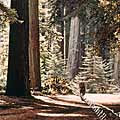 |
It didn't take the club long to start going on the little summer jaunts that eventually became the Bohemian Grove encampment. In the summer of 1873 several members took the Sausalito Ferry to the charming little Marin County town of Sausalito for an afternoon picnic, and by 1878 they had made the trip into an all-day occasion. Gradually a day turned into a weekend, and then into a trip further north to Santa Rosa County, to an area then know as Meeker's Grove, where the "Cremation of Care" was first performed in 1880. Throughout the 1880s, the members simply rented Meeker's Grove for their outings, and even went to a nearby setting in one year.
But in the 1890s, when Mr. Meeker was thinking about selling his redwood grove to the logging companies that were working nearby, the Bohemians decided the Grove was now too much part of their heritage to abandon. So they decided to buy it, at the time a mere 160 acres. Then another 120 acres was added in the next few years. When a real-estate development was started on nearby land in 1913, the club moved to stop that "threatened encroachment" by buying hundreds and hundreds more acres. Land purchases continued throughout the decades, and the Grove reached its present size of 2,700 acres in 1944. (Some controversy has arisen in recent years over the Bohemian Club's plans to log its own property, ostensibly in the name of fire prevention; see the Los Angeles Times, 8/21/06, or the San Francisco Chronicle, 7/12/07.)
In terms of present-day ceremonies and plays, everything was in place by the late 1890s. Several magazines of the era wrote about the occasion, stressing its cultural aspects. Visiting dignitaries were taken to the Grove when they came to the city. A visit by President Teddy Roosevelt and his family in 1905 was duly mentioned in a city newspaper.
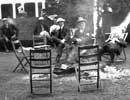 |
The Bohemian Club struggled mightily in the late 19th century to establish its ties with "real Bohemianism." Ambrose Bierce, later to be one of the fathers of West Coast Bohemianism, and the author of such semi-classics as The Devil's Dictionary, was a founding member, although at that time he was listed as an employee at the federal mint. So was poet Charles Warren Stoddard, who in 1876 gained great notoriety by accompanying New York's so-called "Queen of Bohemia," Ada Clare, on a sightseeing trip in Hawaii. Writers Bret Harte and Mark Twain were made honorary members. George Sterling, who had an uncle who was a prosperous real-estate man, but himself took a vow of poverty so he could be a real Bohemian in the Parisian sense, became one of the leaders of Western Bohemianism when be turned to poetry and was asked to join the Bohemian Club in 1904 -- which gave it a renewed air of authenticity. Even socialist author Jack London, who resisted the label of Bohemian for that of vagabond, was acceptable for membership at the turn of the century, although there was some concern expressed over his radical ideas and his fancy white silk shirts with long, flowing ties.
Meanwhile, the banter between artists and business leaders continued, based on the usual human tendency to romanticize "the good old days." In 1880, a mere 8 years after the club's founding, a group of painters and writers protested that "the present day is not as the past days, the salt has been washed out of the club by commercialism, the chairs are too easy and the food too dainty, and the true Bohemian spirit has departed." Around the turn of the century one early member anonymously decried this change in spirit in a little booklet on "Early Bohemia." "The entering of the money-social element has not benefited the club, as a Bohemian Club," he claimed. Now the club had "social aspirations which means death to genius and a general dead-level mediocrity."
But enough of this kind of stuff. A little history goes a long way when it comes to the Bohemian Club because it's always the same old story.
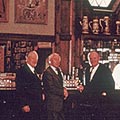 |
The Bohemians have a downtown "clubhouse" that is their main base of operations. It is an imposing six-story building only a few blocks from the financial district of downtown San Francisco. It contains all the amenities of the usual upper-class club, except that it has no athletic facilities whatsoever. For more active pursuits, such as swimming, people have to become members next door at the Olympic Club or up the hill a few blocks at the Pacific Union Club.
The main floor of the clubhouse contains the traditional oversized reading room with large stuffed chairs. The reading room looks like it was developed from one of the traditional clubman cartoons in The New Yorker. It features newspapers and magazines from all over the world, little statues on pedestals and tables, high-vaulted ceilings, a plush Oriental rug, and members reading their Wall Street Journals. "It's almost like a church in its atmosphere," says one non-businessman member.
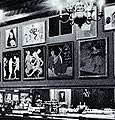 |
There's also an equally large domino room on the main floor, where men can satisfy their gaming passions at little green tables seating four people. Lunchtime tournaments are held quite regularly. The pride of the main floor, however, is the "cartoon room," an extremely spacious barroom, complete with piano and small stage, and decorated with the paintings, handbills, posters, and cartoons drawn by famous club artists for jinks and testimonial dinners of the past. Dice lie conveniently on the bar itself so gentlemen can indulge their gambling urge as a means of determining who signs the check for the drinks. In the first picture at right, you can see some members having a drink there; notice the drawing of an owl on the window above the bar. The owl is the totem animal of the Bohemian Club because it is wise, nocturnal, and discreet. The second picture provides a close-up of the cartoon room in the old days.
Just off the cartoon room there is a little art gallery. The small shows in the gallery are changed frequently, and of course feature the work of associate members of the club.
A very large dining room and a library room occupy the second floor. The dining room is used for daily lunches as well as for most of the regular Thursday night club entertainments. (For generations, Thursday night was maid's night off everywhere in the United States, a small but revealing sign of the nationwide nature of the upper class.) On the same floor is a smaller dining room called the Grove Room. Its walls are completely covered with beautiful murals of the center of the Grove. The Grove Room is used for more intimate luncheons and parties.
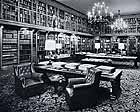 |
This next picture shows the library. The big bulky books on the front table are scrapbooks containing pictures and stories from Grove encampments.
For extremely large parties, testimonial dinners, and dances, there are a reception room and a banquet room in the basement. These rooms, along with the large art gallery on that floor, are sometimes rented by members for private parties and wedding celebrations. The subbasement of the clubhouse is a large theater (seating capacity: 611) where the biggest performances of the regular year are held. The theater also is in constant use for rehearsals for plays that will be given at the Grove, and for orchestra and band practice. Right behind the theater there is a shop for making stage sets, as well as costume rooms and makeup rooms.
The top two floors of the clubhouse contain small meeting rooms, rehearsal rooms, and several small apartments and rooms, which usually are rented to older resident members or out-of-town members temporarily located in San Francisco. There is a glass-covered sun deck on the roof.
The Bohemian Club is governed by a 15-man board of directors elected from among the regular members by a vote of regular members only. The directors, of course, do very little of the day-to-day work themselves. To carry out their wishes they have a hired manager, who in turn has a large staff of cooks, waiters, carpenters, and laborers.
Like most organizations in the United States, the club is run through a set of semiautonomous committees, and it is the job of the board of directors to appoint these committees. In this case there are such committees as a Jinks Committee to look after shows and plays, a Grove Committee to take care of the maintenance of the Grove, a House and Restaurant Committee to direct the dining facilities, an Art Committee, a Library Committee, and a Membership Committee.
Perhaps the most enjoyable service is on the Wine Committee. It meets about five times a year for "working" sessions. According to one annual report, the committee savored 35 new wines that year, accepting only 10 to a club stock that includes well over 125 different wines. The committee also makes sure that 3,500 bottles of wine are available for purchase by members and guests at the Grove encampment. The head of the committee for years was one of the world's foremost authorities on wines and the winemaking process, a professor of viticulture at the University of California, Davis.
The Grove Committee was first formed in 1900 when the club finally purchased the land it had been using for many of its encampments since 1880. The Grove Committee has to oversee the maintenance of the many buildings which have been added to the site, including the beautifully designed Grove Clubhouse that overlooks the river, built in 1904. Additionally, there is a parking lot which must be continually enlarged, wells that have to be deepened, and a dispensary that has to have medical supplies (for example, 370 people checked into the dispensary for one small thing or another in 1970, but two people died, one at the Grove, one in an ambulance on the way to San Francisco). The committee also has to have the Grove ready for such activities as the Spring Jinks (a weekend of entertainment), the June Picnic (when members bring their wives to the Grove for a Saturday afternoon), and private parties by members. Thousands of people visit the Grove between encampments for one occasion or another.
The Jinks Committee and the House and Restaurant Committee have a common concern: encouraging a large enough attendance at luncheons and entertainments to pay the financial bills. With costs going up all the time, there is a fear that club operations will slip into the red. "To put it simply, we need more people using the club at lunch time," says an annual report of the House and Restaurant Committee. "Our luncheon business has dropped off for many reasons, and great effort will be put forth in the future by the new committee, we trust, to induce the membership to come to lunch at the club more often.
The Jinks Committee constantly worries over attendance at the programs it puts on at the downtown clubhouse during the year. "They have to reach a minimum attendance or they're in trouble," says my informant close to Jinks operations. "The question always is -- will a given play or show draw well? Will 400 or so people show up for dinner and drinks?" In short, the Bohemian Club is a large enough institution to have needs of its own. Leaders have to devise ways of tempting members to come to the club more often -- so that the needs of the institution can be met. The club no longer merely serves the needs of its members. Now the members must serve the needs of the club.
The Membership Committee is the major gatekeeper of the Bohemian Club, for membership is of course by invitation only. A potential member must be nominated by at least two regular members of the club who will vouch for his character and describe the qualities that will make him a "good Bohemian." (However, honorary associates, those who have reached a retirement age, are allowed to sponsor applicants for associate membership, which means new performing members can be recruited more readily.) The prospect himself must fill out a membership application form obtained for him by his sponsors. The form requests the usual information necessary on any application for credit or a license, along with such tidbits as wife's maiden name, business or professional connections, other club memberships, and the names of five people in the club who know him. The hopeful candidate then returns this membership application to his first sponsor, who fills out a part of it which asks for information on "musical, oratorical, literary, artistic, or histrionic talents." This sponsor also provides the names of three members of the club who are known by him to be well acquainted with the applicant. Next the form goes to the second sponsor, who answers the same questions as the first sponsor in addition to listing five members of the club to whom the applicant is personally known.
The prospect then makes appointments to see individually the members of the Membership Committee. He goes by their places of business or law to be asked questions about why he wants to become a member of the Bohemian Club, but even more to be lectured by them about what it means to be a "good Bohemian."
In the meantime, the Membership Committee has been soliciting letters of recommendation about the candidate from some or all of the club members suggested by the candidate and his sponsors as people who know him well. The committee also circulates a monthly notice to all club members, listing people being considered for membership and asking for any opinions (positive or negative) anyone might have on any of the people listed. The notice lists the person's name, age, occupation, and sponsors. Finally, after this rigorous screening, there is the vote. Nine of the eleven members of the Membership Committee have to favor the candidate before he can become a member. Three negative votes and he has to wait at least three years before being proposed again.
Gaining the necessary votes does not make a person automatically a member, however, for there is a long waiting list. Many hundreds of people are backed up to become regular resident members. I talked to one regular member who had been on the waiting list for over ten years before becoming a member.
New associate members have no trouble claiming their rightful place -- there are no waiting lists for men of talent. "And if you are jinks material, which means you'll write or perform in Grove plays and shows, then they'll zip you right through," says one informant familiar with jinks operations. It is not surprising that the club constantly searches for jinks material. The talented members not only have the two-week encampment to plan for, but they must put on some kind of performance every Thursday night from October to May. "Over the years," says the club handbook, "the demands on the talented members of the Club have increased tremendously with three major productions and 12 Campfire or related programs during the Encampment and 20 or more Thursday nights in the City Club with five or six of these listed as major events."
Even this brief overview of the club and its activities makes clear that it is a 24-hour, 12-months-a-year operation. As a recent president used to say in his letter of congratulations to new members, "You have joined not only a club, but a way of life."
The highlight of a Grove encampment is an opening day initiation ceremony called "The Cremation of Care," in which the campers are given permission to forget their worldly duties and responsibilities, and instead focus on having a good time, just like in the old days, when they were young and supposedly carefree. Although the ceremony is very elaborate and has a long tradition, readers have to understand at the outset that it is a lark, a spoof of ceremonies, that has no deep or serious intent, contrary to what some conspiracy theorists have claimed. It is just what it claims to be: a way to ease everyone into a mood where they can relax and enjoy themselves. The scenario unfolds something like this:
The boys begin to arrive at the Bohemian Grove on the Saturday closest to the middle of July for what will be a two-week encampment. In actuality, most of them will just attend during one or two of the three weekends included in the encampment, jetting in to the nearby Santa Rosa airport from all over the country, or driving up from San Francisco.
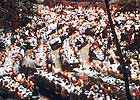 |
As they arrive, they first get settled at their camps, then wander around visiting with old friends. That night they have their first dinner in the huge open-air dining circle. They hear flowery welcoming speeches, they give a cheer to the "Old Guard," those who have been in the club for 40 or more years, and they pay their respects to the "Fallen Leaves," those who have died in the past year.
But the highlight of the evening is the Cremation of Care, an initiation into the spirit of the encampment. It is all very fancy. The script varies only slightly each year. It is also a put-on, a mock of rituals -- but it is a ritual ceremony nonetheless. Postmodernists might call it a meta-ritual. It is meant to signal that the encampment is a time for relaxation, drinking, and fun. It is a return to the summer camp days of their youth.
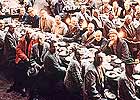 |
To gain a sense of what it's like to take part, imagine yourself comfortably seated in the beautiful open-air dining hall. It's early evening and the clear July air is still pleasantly warm. Dusk has descended, you have finished a sumptuous dinner, and you are sitting quietly with your drink, listening to the nostalgic welcoming speeches and enjoying the gentle light and the eerie shadows that are cast by the two-stemmed gaslights flickering softly at each of the several hundred outdoor banquet tables.
You are part of an assemblage that has been meeting in this redwood grove 65 miles north of San Francisco for well over a hundred years. It is not just any assemblage, for you are a captain of industry, a well-known television star, a banker, a famous artist, or maybe a member of the President's cabinet. You are one of 1,500 men -- women are not allowed -- gathered together from all over the country for this annual encampment of the rich and the famous. And you are about to take part in a strange ceremony that has marked every Bohemian Grove gathering since 1880.
Out of the shadows on one of the hillsides near the dining circle there emerges the low, sad sounds of a funeral dirge. As you turn your head in its direction you faintly see the outlines of men dressed in pointed red hoods and red flowing robes. Some of the men are playing the funereal music; others are carrying long torches whose flames are a spectacular sight against the darkened forest.
As the procession approaches the dining circle, the dim figures become more distinct, and attention fixes on several men not previously noticed. They are carrying a large wooden box. Upon closer inspection the box turns out to be an open coffin, and in that coffin is a body, a human body that looks real enough to be lifelike at a glance, but only an imitation, naturally, made of black muslin wrapped around a wooden skeleton. This is the body of Care, symbolizing the concerns and woes that important men supposedly must bear in their daily lives. It is this guy, Mr. Dull Care, who is to be cremated this first Saturday night of the two-week encampment of the Bohemian Grove.
The cortege now trails slowly past the dining area, and the men in the dining circle fall into line behind the hooded priests and pallbearers, following the body of Care toward its ultimate destination. The entire parade (mostly white, mostly elderly) makes its way along a road leading to a picturesque little lake that is yet another of the sylvan sights the Bohemian Grove has to offer.
It takes the communicants about five minutes to make their march to this new setting. Once at the lake the several priests and the body of Care go off to the right, in the direction of a very large altar which faces the lake. They are accompanied by a cast of 250 elders, torchbearers, shore patrols, fire tenders, production managers, and woodland voices.
The major parts in this drama are played by "associate" or "performing" members of the club, middle-class men with musical, theatrical, artistic, or literary talents. But sometimes very important men have small walk-on roles that show they are just one of the gang when they are at the Bohemian Grove. They are "carrying a spear for Bohemia," as the saying goes, which means they are chipping in, doing their part, being good sports.
If the year were 1996, there would be three spear-carriers doing a little add-on part. They are former president George H. W. Bush, actor Clint Eastwood, and fabled news anchor Walter Cronkite. They are playing the parts of "Lakeside Frogs," and they are chanting like the frogs in the famous "Bud-WEI-ser" TV ads of the 1990s, only they keep croaking "cre-MAY-shun, cre-MAY-shun, cre-MAY-shun."
 |
The followers, talking quietly and remarking on the once-again-perfect Grove weather, move to the left so they can observe the ceremony from a green meadow on the other side of the lake. Drinks in hand, they will be about fifty to a hundred yards from the altar, which looms skyward thirty to forty feet and reveals itself to be in the form of a huge Owl, whose cement shell is mottled with primeval green mosses. This Owl is the totem animal of Bohemia, found not only at the lake, but everywhere you go in the Grove, and on shot glasses, coffee cups, and stationery.
While the spectators seat themselves across the lake, the priests and their entourage continue for another two or three hundred yards beyond the altar to a boat landing. There the bier is carefully transferred onto the Ferry of Care, which will carry the body to the altar later in the ceremony. Once the ferry is loaded, the torches are extinguished and the music ends. The attention of the spectators on the other side of the lake slowly drifts back to the Owl shrine; it is illuminated by a gentle flame from the Lamp of Fellowship, which sits at its base.
Cremation? A guy named Dull Care? A former president of the United States playing the part of a frog and chanting "cre-MAY-shun?" A totem animal and a Lamp of Fellowship? Strange, but true. You are starting to get the picture of just how hokey this all is.
People who have seen the ceremony before nudge you to keep your eye on the large redwood next to the Owl. Moments later an offstage chorus of "woodland voices" begins to sing. Then a spotlight illuminates the tree you've been watching, and there emerges from it a hamadryad, a "tree spirit," whose life, according to Greek mythology, is intimately bound up with the tree in which it lives. The hamadryad begins to sing, telling the supplicants that beauty and strength and peace are theirs as long as the trees of the Grove are there. It sings of the "temple-aisles of the wood" that are made for "your delight," and implores the Bohemians to "burn away the sorrow of yesterday" and to "cast your grief to the fires and be strong with the holy trees and the spirit of the Grove."'
With the end of this uplifting song, the hamadryad returns to its tree, the chorus silences, and the light on the tree fades out. Now there's only natural illumination from the moon and stars, and it's time for the high priest and his many assistants to enter the large area in front of the Owl.
"The Owl is in his leafy temple," intones the high priest. "Let all within the Grove be reverent before him." He beseeches the spectators to be inspired and awed by their surroundings, noting that this is Bohemia's shrine. Then he invokes the motto of the club, "Weaving spiders, come not here!" That's a line from Shakespeare's "A Midsummer Night's Dream"; it is supposed to warn members not to discuss business and worldly concerns, and instead concentrate on the arts, literature, and other pleasures within the portals of Bohemia.
The priest next walks down three large steps to the edge of the lake. There he makes a flowery speech about the ripple of waters, the song of birds, the forest floor, and evening's cool kiss. Again he calls on the members to forsake their usual concerns: "Shake off your sorrows with the City's dust and scatter to the winds the cares of life." A second and third priest then recall to memory deceased friends who loved the Bohemian Grove, and the high priest makes yet another effusive speech, the gist of it being that "Great Nature" is a "refuge for the weary heart" and a "balm for breasts that have been bruised."
The pace is picking up. A brief song is sung by the chorus and suddenly the high priest proclaims: "Our funeral pyre awaits the corpse of Care!" A horn is sounded at the boat landing. Behold, the Ferry of Care, with its beautifully ornamented frontispiece, begins its brief passage to the foot of the shrine. Its trip is accompanied by the music of a barcarole (a barcarole is the song of Venetian gondoliers as they pole through the canals of Venice). Listening to the barcarole, it becomes ever more clear how many little extra bits and pieces of culture have been borrowed from many parts of the world by the Bohemians who lovingly developed this ritual over its long history.
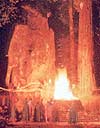 |
The bier arrives at the steps of the altar. The high priest inveighs against Dull Care, the archenemy of Beauty. He shouts, "Bring fire," and the torchbearers enter (18 strong). Then the acolytes quickly seize the coffin, lift it high above their heads, and carry it triumphantly to the pyre in front of the mighty Owl. It seems that Care is about to be consumed by flames.
Ah, but not yet. Suddenly there is a great clap of thunder and a rush of wind. Peals of loud, ugly laughter come ringing down from a hill above the lake. A dead tree is illuminated in the middle of the hillside, and Care himself bellows forth with a thundering blast:
"Fools! Fools! Fools! When will ye learn that me ye cannot slay? Year after year ye burn me in this Grove, lifting your puny shouts of triumph to the stars. But when again ye turn your feet toward the marketplace, am I not waiting for you, as of old? Fools! Fools! To dream ye conquer Care!"
The high priest is taken aback by this impressive outburst, but not completely humbled. He replies that it is not all a dream, that he and his friends know they will have to face Care when their holiday is over. They are happy that the good fellowship created by the Bohemian Grove is able to banish Care even for a short time. So the high priest tells Care, "We shall burn thee once again this night and in the flames that eat thine effigy we'll read the sign: Midsummer sets us free."
 |
Dull Care, however, is having none of this. He tells the high priest in no uncertain terms that priestly fires are not going to do him in. "I spit upon your fire," he roars, and with that there is a great explosion and all the torches are immediately extinguished. The only light remaining comes from the small flame in the Lamp of Fellowship.
Things are clearly at an impasse. Care may win out after all. There is only one thing to do: turn to the great Owl, the great totem animal of Bohemia, chosen as the group's symbol primarily for its mortal wisdom -- and only secondarily for its discreet silence and its nightly prowling. The high priest falls to his knees and lifts his arms toward the shrine. "Oh thou, great symbol of all mortal wisdom," he cries. "Owl of Bohemia, we do beseech thee, grant us thy counsel!"
The inspirational music of the "Fire Finale" now begins, and an aura of light glows about the Owl's head. The Owl is going to rise to the occasion! And if it's the 1990s, it's none other than the voice of good old Walter Conkrite, although the part usually goes to a deep-voiced drama professor. After a pause, the sagacious bird finally speaks. No fire, he tells the assembled faithful, can drive out Care if that fire comes from the mundane world, where it is fed by the hates of men. There is only one fire that can overcome the great enemy Care, and that, of course, is the flame which burns in the Lamp of Fellowship on the Altar of Bohemia. "Hail, Fellowship," he concludes, "and thou, Dull Care, begone!"
The priest smacks himself on the side of the head, as if to say he wonders why he didn't think of that profound point. The light goes out on the dead tree. The high priest leaps to his feet and bounds up the steps, snatches a burned-out torch from one of the bearers, and relights it from the flame of the Lamp of Fellowship. Just as quickly he ignites the funeral pyre and triumphantly hurls the torch into the blaze.
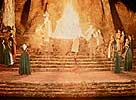 |
The orchestral music in the background intensifies as the flames leap higher and higher. The chorus sings loudly about Dull Care, archenemy of Beauty, calling on the winds to make merry with his dust. "Hail, Fellowship," they sing, echoing the Owl. "Begone, Dull Care! Midsummer sets us free!" The wailing voice of Care gives its last gasps, the music gets even louder, and fireworks light the sky and fill the Grove with the reverberations of great explosions. The band, appropriately enough, strikes up "There'll Be a Hot Time in the Old Town Tonight." Care has been banished.
As this climax approaches, some 50 minutes after the march began, the quiet onlookers on the other side of the lake begin to come alive. After all, it is a night for rejoicing. The men begin to shout, to sing, to hug each other, and dance around. They have been freed by their priests and their Owl for some good old-fashioned hell raising. They couldn't be happier if they were back in college and their fraternity had won an intramural football championship.
Now the ceremony is over. The revelers, initiated into the carefree attitude of the Bohemian Grove, break up into small groups as they return to the camps that crowd next to each other in the central area of the Grove. It will be a night of storytelling and drinking for the men of Bohemia as they sit around their campfires or wander from camp to camp, renewing old friendships and making new ones. They will be far away from their responsibilities as the decision makers and opinion molders of corporate America.
It's straight out of tribal life the world over. No women. Lots of drinking and boasting. Men will be men, and boys will be boys.
The Cremation of Care is the most spectacular event of the midsummer retreat, but there are several other entertainments as well. Before the Bohemians return to the everyday world, they will be treated to plays, variety shows, song fests, shooting contests, art exhibits, swimming, boating, and nature rides. Of all these delights, the most elaborate are the two Jinks: High Jinks and Low Jinks.
Among Bohemians, planned entertainment of any real magnitude is called a Jinks. This nomenclature comes from the earliest days of the club, when its members were searching for precedents and traditions to adopt from the literature and entertainment of other times and other places. In the case of Jinks, they had found a Scottish word which denotes, generally speaking, a frolic, although it also was used in the past to refer to a drinking bout which involved a matching of wits to see who paid for the drinks. Bohemian Club historiographers, however, claim the word was gleaned from a more respectable source, Guy Mannering, a novel by Sir Walter Scott; there the High Jinks are a more elevated occasion, with drinking only a subsidiary indulgence.
The early Jinks at the Grove slowly developed into more and more elaborate entertainments. Already by 1902 the High Jinks had become what it is today, a grandiose, operetta-like extravaganza written and produced by club members for its one-time-only presentation in the Grove. The High Jinks, which is presented on the Friday night of the last weekend, is considered the most important formal event of the encampment.
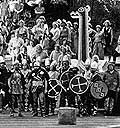 |
Most of the plays written for the High Jinks have a mythical or fantasy theme, although a significant minority have a historical setting. Any moral messages center on inevitable human frailty, not social injustice. There is no spoofing of the powers-that-be at a High Jinks; it is strictly a highbrow occasion. A few titles give the flavor: The Man in the Forest, The Cave Man , The Fall of Ug, The Rout of the Philistines, The Golden Feather, Johnny Appleseed, A Jest of Robin Hood, Rip Van Winkle, The Bonnie Cravat, The Fall of Pompeii.
A priest, of all unlikely people, holds the honor of being the only person to be the subject of two Grove plays. He is the Patron Saint of Bohemia, Saint John of Nepomuck (pronounced NAY-po-muk), a man who lived in the thirteenth century in the real Bohemia that is now part of Czechoslovakia. Saint John received his unique distinction among latter-day Bohemians in 1882, when his sad but courageous story was told in a jinks "sired" (the club argot for master of ceremonies) by the poet Charles Warren Stoddard.
Saint John was a cutup in his youth, but had forsaken ephemeral pleasures -- or at least most of them -- for the priesthood. One of his first assignments was as a tutor to the heir apparent to the kingship of Bohemia. John soon became fast friends with the fun-loving prince, often joining him in his spirited and amorous adventures. When the prince became king, he made Saint John the court confessor.
All went well for Saint John until the king began to suspect that his beautiful queen was having a love affair with a local nobleman. To allay his suspicions, the king naturally turned to his loyal friend and teacher, Saint John of Nepomuck, demanding that this former companion in many revelries reveal to him the most intimate confessions of the queen. Saint John refused. The king pleaded, but to no avail. Then the king threatened him, which had no effect either. Finally, in a fit of rage, he ordered Saint John hurled into the river to drown. John chose to die rather than reveal a woman's secrets. Here, truly, was a remarkable fellow, and his story appealed mightily to the San Francisco Bohemians of the nineteenth century.
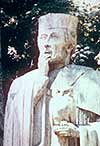 |
Several months after the poet Stoddard introduced Saint John to his fellow Bohemians, a small statue of Saint John arrived at the clubhouse in San Francisco from faraway Czechoslovakia. It seems one of the people present for Stoddard's talk had been Count Joseph Oswald Von Thun of Czechoslovakia, who had been much taken by the club and its appreciation of his fellow countryman. Upon his return to Czechoslovakia be had commissioned a woodcarver to make a replica of the statue of Saint John which adorns the bridge in Prague near the place of his drowning.
This unexpected gift still guards the library room in the Bohemians' large club building in San Francisco -- except during the encampment at the Grove, that is. For that event the statue is carefully transported to a hallowed tree near the center of the Grove, where Saint John, with his forefinger carefully sealing his lips, can be a saintly reminder of the need for discretion.
The legend surrounding Saint John of Nepomuck became part of the oral tradition of the Bohemian Club. New members inevitably hear the story when they happen upon the statue while being shown around the city clubhouse or the Grove. But oral tradition is not enough for a patron saint, and the good man's legend was therefore enacted in a Grove play in 1921 under the title St. John of Nepomuck. It was retold in 1969 by a different author under the title St. John of Bohemia.
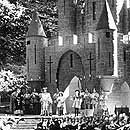 |
How good are the Grove plays? "Pretty darn good," says one member who knows theater. He thinks maybe one in ten High Jinks would be a commercial success if produced for outside audiences. Another member is not so sure about their general appeal. "They're damned fine productions," he claims, "but they are so geared to the special features of a Grove encampment, and so full of schmaltz and nostalgia, that it's hard to say how well they'd go over with ordinary audiences."
Whatever the quality, the plays are enormously elaborate productions, with huge casts, large stage sets, much singing, and dazzling lighting effects. "Hell, most stages wouldn't hold a Grove production," said our second informant. "That Grove stage is about ten thousand square feet, and there are all sorts of pathways leading into it from the hillside behind it. Not to mention the little clearings on the hillside which are used to great effect in some plays."
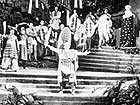 |
A cast for a typical Grove play easily runs to seventy-five or one hundred people. Add in the orchestra, the stagehands, the carpenters who make the sets, and other supporting personnel, and over three hundred people are involved in creating the High Jinks each year. Preparations begin a year in advance, with rehearsals occurring two or three times a week in the month before the encampment, and nightly in the week before the play.
Costs are on the order of $130,000 to $150,000 per High Jinks in 2004 dollars, a large amount of money for a one-night production which does not have to pay a penny for salaries (the highest cost in any commercial production). "And the costs are talked about, too," reports my second informant. "'Hey, did you hear the High jinks will cost $150,000 this year?' one of them will say to another. The expense of the play is one way they can relate to its worth."
The High Jinks is the pride of the Grove, but a little highbrow stuff goes a long way among clubmen, even clubmen who like to think of themselves as cultured. From the early beginnings of the club, the High Jinks has been counterbalanced by the more slapstick and ribald fun of Low Jinks. For many years the Low Jinks were basically haphazard and extemporaneous, but slowly they too became more elaborate and professional as the Grove grew from a few campers on a weekend holiday to a full-blown two-week encampment which requires year-round planning and maintenance. Now the Low Jinks is a specially written musical comedy requiring almost as much attention and concern as the High Jinks. Personnel requirements are slightly less-perhaps 200-250 people to the 300-350 needed for High Jinks. Costs also are half or less than for a High Jinx.
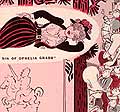 |
The subject matter of the Low Jinks is very different from that of the High Jinks. The title of the first formal Low Jinks in 1924 was The Lady of Monte Rio, which every good Bohemian would immediately recognize as an allusion to the ladies of the evening who are available in certain inns and motels near the Grove. The 1968 Low Jinks concerned "The Sin of Ophelia Grabb" (whose program is pictured here), a vulgar play on words if there ever was one. Ophelia lived with Letchwell Lear in unwedded bliss even though she was the daughter of the mayor of Shady Corners. "Thrice Knightly," another recent Low Jinks, also needs no explanation, especially to old fraternity boys who know that "once a king always a king, but once a knight is enough."
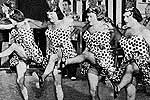 |
Since there are no women allowed in the Bohemian Club, men have to dress in drag and play women's parts. (An example from a 1957 production is pictured here.) In 1989 a male member of the cast called the burly men playing the parts of women "heifers," which soon led the audience to moo each time the heifers appeared on the stage.
The Cremation of Care, the High Jinks, and the Low Jinks are productions involving hundreds of ordinary Bohemian Club members. They require planning, coordination, and money, and Bohemians are proud of the fact that they are part of a club which creates its own theatrical enjoyments. However, the Bohemians are not averse to enjoying professional entertainment by stars of stage, screen, and television. For this, there are the Little Friday Night and the Big Saturday Night.
The Little Friday Night is held on the second weekend of the encampment. The Big Saturday Night is on the third weekend-it closes the encampment. Both are shows made up of acts put on by famous stars. All of this talent is free, of course. No one would think of asking for money to perform for such a select audience, and if anyone should think to ask, he immediately would be dis-invited. People are supposed to understand it is an honor to entertain those in attendance at the Bohemian Grove.
Formal Grove shows and informal camp shenanigans do not exhaust the possibilities of the Bohemian Grove. Members can find a number of other ways to amuse themselves.
 |
Some wander about quietly, drink in hand, enjoying the redwood trails. Others walk down the River Road to look at the meandering water of the Russian River 150 feet below; often they take the winding path down to the river and its beach, where they sit on the large beach deck, wade in the shallow water along the banks, swim in the specially developed swimming hole, or even paddle out in one of the Grove canoes.
Others can be found taking part in the skeet shooting and trap shooting that are provided. Some take regularly scheduled "rim rides" on Grove buses, journeying to the more distant parts of the Grove's several thousand acres while a tour guide recounts the natural history of the area. Many plan their late morning visit to the Civic Center (a group of small buildings which serve as message center, barber shop, and drug store) so they can make it to the noon organ concert which is held each day by the lake. (Seated at the base of the Owl Statue, the Bohemian band and the Bohemian orchestra each perform one afternoon concert during the encampment.)
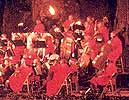 |
A pleasant afternoon can be spent at the Ice House, the beautiful redwood building that houses an annual art exhibit made up of paintings, photographs, and sculpture created by Bohemian Club members. Over three hundred original works of art are usually available for viewing. For evenings without large productions, there are less formal Campfire Circle entertainments featuring the band, the orchestra, the chorus, or individual storytellers and entertainers.
Skeet shooting, hiking, swimming, art exhibitions -- there is plenty to see and do in the Bohemian Grove even when a big production is not being staged. It is truly a place of many delights. But, despite all these attractions, it remains most of all a place to rest and relax in the company of friends.
Entertainment is not the only activity at the Bohemian Grove. For a little change of pace, there is intellectual stimulation and political enlightenment every day at 12:30 p.m. Since 1932 the meadow from which people view the Cremation of Care also has been the setting for informal talks and briefings by people as varied as entertainers, professors, astronauts, business leaders, cabinet officers, future presidents, and former presidents.
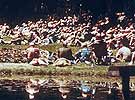 |
The cabinet officers, politicians, generals, and governmental advisers are the rule rather than the exception on weekends. Figures from the worlds of art, literature, and science are more likely to make their appearance during the weekdays of the encampment, when Grove attendance may drop to four or five hundred (since the 1960s many of the members only come to the Grove for the weekends because they cannot stay away from their corporations and law firms for the full two weeks).
Members vary as to how interesting and informative they find the Lakeside Talks. Some find them useful, others do not, probably depending on their degree of familiarity with the topic being discussed. It is fairly certain that no inside or secret information is divulged, but a good feel for how a particular problem will be handled is likely to be communicated. Whatever the value of the talks, most members think there is something very nice about hearing official government policy, orthodox big-business ideology, and new scientific information from a fellow Bohemian or one of his guests in an informal atmosphere where no reporters are allowed to be present.
Politicians apparently find the Lakeside Talks especially attractive. "Giving a Lakeside" provides them with a means for personal exposure without officially violating the injunction "Weaving spiders, come not here." After all, Bohemians rationalize, a Lakeside Talk is merely an informal chat by a friend of the family.
Some members, at least, know better. They realize that the Grove is an ideal off-the-record atmosphere for sizing up politicians. "Well, of course when a politician comes here, we all get to see him, and his stock in trade is his personality and his ideas," a prominent Bohemian told aNew York Times reporter who was trying to cover Nelson Rockefeller's 1963 visit to the Grove for a Lakeside Talk. The journalist went on to note that the midsummer encampments "have long been a major showcase where leaders of business, industry, education, the arts, and politics can come to examine each other."'
There's no better witness to the importance of Lakeside Talks than President Richard M. Nixon. He accords them a prominent role in his memoirs, RN: The Memoirs of Richard Nixon (Grosset & Dunlap, 1978). He begins with an account of future President Dwight D. Eisenhower's appearance at the Grove. After noting he had met Ike briefly in 1948, he says that he had a chance to take his measure when the well-liked general came to the Bohemian Grove to give a Lakeside Talk:
"In the summer of 1950, I saw him at even closer quarters at the Bohemian Grove, the site of the annual summer retreat of San Francisco's Bohemian Club, where each year members of this prestigious private men's club and their guests from all over the country gather amidst California's beautiful redwoods. Herbert Hoover used to invite some of the most distinguished of the 1,400 men at the Grove to join him at his "Cave Man Camp" for lunch each day. [Nixon was a member, too.] On this occasion Eisenhower, then president of Columbia University, was the honored guest. Hoover sat at the head of the table as usual, with Eisenhower at his right. As the Republican nominee in an uphill Senate battle, I was about two places from the bottom."
"Eisenhower was deferential to Hoover but not obsequious. He responded to Hoover's toast with a very gracious one of his own. I am sure he was aware that he was in enemy territory among this generally conservative group. Hoover and most of his friends favored Taft and hoped that Eisenhower would not become a candidate. Later that day, Eisenhower spoke at the beautiful lakeside amphitheatre. It was not a polished speech, but he delivered it without notes and he had the good sense not to speak too long. The only line that drew significant applause was his comment that he did not see why anyone who refused to sign a loyalty oath should have the right to teach in a state university."
"After Eisenhower's speech we went back to Cave Man Camp and sat around the campfire appraising it. Everyone liked Eisenhower, but the feeling was that he had a long way to go before he would have the experience, the depth, and the understanding to be President. But it struck me forcibly that Eisenhower's personality and personal mystique had deeply impressed the skeptical and critical Cave Man audience." (page 80-81 of the Nixon memoirs)
Nixon next refers to Lakeside Talks in the context of his second run at the presidency in 1967. He was now suspect goods after failing to win in 1960, so he had to prove himself all over again. A Lakeside Talk was a key setting, the start of his comeback, he says:
"If I were to choose the speech that gave me the most pleasure and satisfaction in my political career, it would be my Lakeside Speech at the Bohemian Grove in July 1967. Because this speech traditionally was off the record it received no publicity at the time. But in many important ways it marked the first milestone on my road to the presidency."
"The setting is possibly the most dramatic and beautiful I have ever seen. A natural amphitheatre has been built up around a platform on the shore of a small lake. Redwoods tower above the scene, and the weather in July is usually warm and clear. Herbert Hoover had always delivered the [last] Lakeside Speech [of the encampment], but he had died in 1964, and I was asked if I would deliver the 1967 speech in his honor. It was an emotional assignment for me and also an unparalleled opportunity to reach some of the most important and influential men, not just from California but from across the country. In the speech I pointed that that we live in a new world -- 'never in human history have more changes taken place in the world in one generation' -- and that this is a world of new leaders, of new people, of new ideas." [As if we haven't heard that before, including the current generation. It is always so new, always more critical than before, but in fact it is more similar than different -- GWD].
"I led the audience on a tour of the world, tracing the changes and examining the conflicts, finding both danger and opportunity as the United States entered the final third of the twentieth century. I urged the need for strong alliances and continued aid to the developing nations, but I also urged that we should provide our aid more selectively, rewarding our friends and discouraging our enemies and encouraging private rather than government enterprise."
"Turning to the Soviet Union, I noted that even as the Soviet leaders talked peace they continued to stir up trouble, to encourage aggression. and to build missiles. I urged that we encourage trade with the Soviet Union and Eastern Europe, and that 'diplomatically we should have discussions with the Soviet leaders at all levels to reduce the possibility of miscalculation and to explore the areas where bilateral agreements would reduce tensions.' But we should insist on reciprocity: 'I believe in building bridges but we should build only our end of the bridge.' And in negotiations we must always remember "that our goal is different from theirs. We seek peace as an end in itself. They seek victory, with peace being at this time a 'means toward that end.'"
"Looking ahead, I said: 'As we enter this last third of the twentieth century the hopes of the world rest with America. Whether peace and freedom survive in the world depends on American leadership. Never has a nation had more advantages to lead. Our economic superiority is enormous; our military superiority can be whatever we choose to make.'" (page 284)
But rehabilitation through a Lakeside Talk was not all Nixon accomplished at the Bohemian Grove that summer. He also had a "candid discussion" with Ronald Reagan "as we sat outdoors on a bench under one of the giant redwoods." Nixon told Reagan of his plans to enter the primaries. He assured Reagan he would not campaign against any "fellow Republicans." Reagan allegedly professed surprise that there was speculation about his possible candidacy, and claimed he did not want to be a favorite son. According to Nixon, Reagan said "that he would not be a candidate in the primaries." In other words, they came to a deal at the Grove, with Reagan saying he would only enter the primaries if Nixon faltered.
Nixon was so full of himself over the Bohemian Grove, and so pleased to be a member, that he actually wanted to give a Lakeside Talk in 1971 even though he was now the president of the United States. After he got himself an invitation, and the press heard about it, a flap developed, as revealed to me by one of my informants, who was the Grove telephone operator at the time. The press was not about to let the president of the United States disappear into a redwood grove for an off-the-record speech to some of the most powerful men in America. It objected loudly and vowed to make every effort to cover the event, The publicity caused the club considerable embarrassment, and after much hemming and hawing back and forth, the club leaders asked the President to cancel his schedule appearance. A White House press secretary then announced that the President had decided not to appear at the Grove rather than risk the tradition that speeches there are strictly off the public record.
However, Nixon was not left without a final word to his fellow Bohemians. In a telegram to the president of the club, which used to hang at the entrance to the reading room in the San Francisco clubhouse, he expressed his regrets at not being able to attend. He asked the club president to continue to lead people into the woods, adding that he in turn would redouble his efforts to lead people out of the woods. He also noted that, while anyone could aspire to be President of the United States, only a few could aspire to be president of the Bohemian Club.
And yet, when his secret tapes were made available years later, it turns out he also badmouthed the Bohemians: "The Bohemian Club, which I attend from time to time -- is the most faggy goddamned thing you could ever imagine, with the San Francisco crowd. I can't shake hands with anybody from San Francisco." (As quoted in an article in the San Francisco Chronicle on July 18, 2004, page 1, "The Chosen Few," by Adair Lara.)
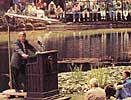 |
Turning to a few post-Nixon examples, the Grove had quite a line-up of Lakeside speakers in 1991, including the African-American lawyer Vernon Jordan, soon to be a prominent confidant of President Bill Clinton. Helmut Schmidt, the former chancellor of West Germany, also appeared (pictured), as did the then-Secretary of Defense, Richard Cheney. George Shultz, the Secretary of State under Reagan, gave a talk called "Agenda for America."
The 1994 encampment made news because of a nasty Lakeside attack on recently defeated President George H. W. Bush, a longtime Bohemian, by a former Secretary of Treasury, William Simon. Simon was a supercilious super-conservative who castigated Bush for allegedly abandoning the Reagan agenda. By that time Simon was a multi-millionaire many times over and a leader in creating the New Right.
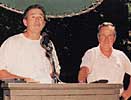 |
In 1995, House Speaker Newt Gingrich delivered the Lakeside Talk on the middle Saturday of the encampment, and former President Bush had his turn on the final Saturday (pictured). He used the occasion to say that his son George W. Bush would make a great president some day.
The featured Saturday speakers in 1996 were Pete Wilson, the Republican Governor of California, and a former Republican Secretary of State.
Perhaps the most striking change in the Lakeside Talks in the 1990s was the complete absence of any appointees from the Clinton Administration. In the past, cabinet members from the Kennedy, Johnson, and Carter administrations were prominent guests and Lakeside speakers. It is safe to say that the Bohemian Club's regular members are now solidly Republican.
So, yes, within the context of the goofing off, pranks, and drinking at the Bohemian Grove, some political business does get done. Republican business. But note that it involves jockeying among politicians for advantage, not serious policy discussions. The Grove is an occasion for some politicking, but it is only one of many such settings.
Not all the entertainment at the Bohemian Grove takes place under the auspices of the committee in charge of special events. The Bohemians and their guests are divided into camps which evolved slowly over the years as the number of people on the retreat grew into the hundreds and then the thousands. These camps have become a significant center of enjoyment during the encampment.
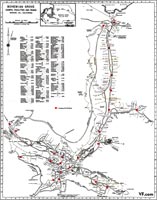 |
| Map of the Grove, |
At first the camps were merely a place in the woods where a half-dozen to a dozen friends would pitch their tents. Soon they added little amenities like their own special stove or a small permanent structure. Then there developed little camp traditions and endearing camp names like Cliff Dwellers, Moonshiners, Silverado Squatters, Woof, Zaca, Toyland, Sundodgers, and Land of Happiness. The next steps were special emblems, a handsome little lodge or specially constructed tepees, a permanent bar, and maybe a grand piano.
Today there are about 120 camps of varying sizes, structures, and statuses. Most have between 10 and 30 members, but there are one or two with about 125 members and several with less than 10. A majority of the camps are strewn along what is called the River Road, but some are huddled in other areas within five or ten minutes of the center of the Grove.
The entertainment at the camps is mostly informal and impromptu. Someone will decide to bring together all the jazz musicians in the Grove for a special session. Or maybe all the artists or writers will be invited to a luncheon or a dinner at a camp. Many camps have their own amateur piano players and informal musical and singing groups which perform for the rest of the members. (There is a special moisture-proof building at the Grove to hold the dozens of expensive Steinway pianos belonging to the club and various camps.)
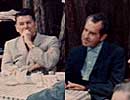 |
But the joys of the camps are not primarily in watching or listening to performances. Other pleasures are created within them. Some camps become known for their gastronomical specialties, such as a particular drink or a particular meal. The Jungle Camp features mint juleps, Halcyon has a three-foot-high martini maker constructed out of chemical glassware. At Owl's Nest it's the Gin Fizz Breakfast -- about a hundred people are invited over one morning during the encampment for eggs benedict, gin fizzes, and all the trimmings(pictured is a 1967 Gin Fizz event with future presidents Ronald Reagan and Richard Nixon as guests).
In the 1970s Poison Oak was famous for its Bulls' Balls Lunch. Each year a cattle baron from central California brings a large supply of testicles from his newly castrated herds for the delectation of Poison Oakers and their guests. No one goes away hungry -- bulls' balls are said to be quite a treat. Meanwhile, one small camp has a somewhat different specialty, which is not necessarily known to members of every camp. It houses a passé pornographic collection which is more amusing than erotic. Connoisseurs do not consider it a great show, but it is an easy way to kill a lazy afternoon.
Almost all camps stress that people from other camps are free to walk in at any time of the day or night. Hospitality and a free drink are the proper form of behavior, and everyone talks about this easy congeniality. Some camps go out of their way to advertise their friendliness. In the little Grove museum featuring birds and mammals from the area, the Rattler's Camp put the following sign above the rattlesnake exhibit: "Anyone looking at this rattlesnake is hereby entitled to a free drink at Rattler's Camp."
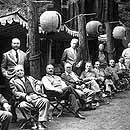 |
A brief history of all the camps is included in the large scrapbooks in the Bohemian Club library room. Most of these histories describe how the camp acquired its name, tell an anecdote or two about the camp or its founders, and then list some of the famous Americans who have been guests there over the generations.
A few camps go so far as to print for the members a history of the camp. The Lost Angels, a camp with a strong Los Angeles contingent, permitted themselves this little indulgence on their fiftieth anniversary in 1958. The history, complete with pictures and membership lists, tells how the founders of the camp broke away from another camp because they felt "lost," only to find themselves half-seriously hassled by the Grove authorities for a campfire that was smoking out fellow Bohemians. The Lost Angels retaliated for this harassment by moving to a somewhat removed hillside, where the next year they built an utterly lavish (by Grove standards) lodge complete with elegant mahogany furniture and special appointments like virgin lambs' wool blankets from the Isle of Wight and lace tablecloths from Ireland. It was a $12,000 joke even in 1908 -- which was about $50,000 by 1958 standards.
The outlandish Lost Angels camp was a huge success in outraging members of other camps. It caused consternation everywhere, inspiring numerous jokes and jingles which are faithfully preserved in Lost Angels lore. However, the final laugh was on the Lost Angels. When they weren't looking, members of other camps stole everything of value. Lost Angels was happy to return to the plainer and simpler atmosphere that the Grove tries to maintain, but it is still regarded as one of the nicest camps in the Grove.
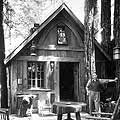 |
Although the official line about Grove camps stresses their essential equality, there are in fact differences among them. The most specialized camps in terms of membership tend to be made up of the singers, musicians, and other performers who are there to entertain the "regular" members. Aviary, the largest camp, is comprised almost exclusively of associate members who are part of the chorus. Tunerville is the camp for members of the club orchestra. The Band Camp is for members of the band. Monkey Block, named after a famous artists' colony in old San Francisco, has a preponderance of artist members. There are, however, artists in several camps other than Monkey Block, and writers and actors are spread out into many different camps where they share tents or tepees with regular members.
Faculty members are distributed among twenty-eight camps. Most of these camps have only one or two faculty members, but two camps, Sons of Toil and Swagatom, had a majority of university types among their membership in the 1970s. Wayside Log, with six faculty members, was known as a hangout for scientists in the same decade.
The businessmen, bankers, lawyers, and politicians of the club are housed among many camps, sometimes with a few performing members sprinkled among them. However, a handful of camps clearly bring together some of the most influential businessmen and politicians in the country. Far and away the most impressive camp in this category is Mandalay, with its expensive lodgings high up the hillside along the River Road, overlooking the lake. "You don't just walk in there," said one informant. "You are summoned." "A hell of a lot of them bring servants along," noted another. A rundown of Mandalay members in any decade reads like an all-star team of the national corporate elite.
Cave Man is another "heavy" camp. It is most famous among members as the camp of former President Herbert Hoover, but it was also the camp of President Richard M. Nixon. Among Cave Man's highly conservative members in the 1970s were leaders of an ultra-conservative think tank, the Hoover Institution, located at Stanford University; a major Nixon fund raiser who was also a director of two major corporations of that day; a newspaper publisher who owned newspapers in Indianapolis and Phoenix; famed aviator Eddie Rickenbacker; and a retired army general. There were also some slightly less conservative Republicans in the group, such as Lowell Thomas, the newscaster; Lowell Thomas, Jr., a director of the Alaska State Bank; and J. E. Wallace Sterling, the chancellor of Stanford University.
Owl's Nest was a high-status camp in the late 1970s and 1980s because Ronald Reagan was a member starting in 1975. His camp buddies included the chairmen or presidents of United Airlines, United California Bank, Dart Industries, Carter-Hawley-Hale Stores, Dean Witter Reynolds & Co, and Pauley Petroleum, all big-deal companies in their day, although some are now merged into other companies. There were also retired top execs from Pacific Telephone (now part of SBC), General Dynamics, and United Airlines
Then there's Hill Billies, notable as George H. W. Bush's camp after he joined the Bohemian Club in 1973. While Reagan was rubbing shoulders with CEO's from United Airlines and United California Bank, Bush was chatting with the presidents of Eastern Airlines and the Bank of America. There were also officers and directors from Blyth Eastman Dillon, a big investment banking firm of the day, along with Procter & Gamble, General Motors, Southern Pacific, Westinghouse Electric, B. F. Goodrich, Mutual Life Insurance of New York, and Metromedia, among others. By the mid-1980s, half of the 26 members were graduates of Yale.
Mandalay, Owl's Nest, Hill Billies, and the Isles of Aves, a camp not mentioned before, were at the heart of Republican administrations in the 1980s. George Shultz, Secretary of State, and William French Smith, Attorney General, were members of Mandalay. Caspar Weinberger, Secretary of Defense, was a member of the Isles of Aves. William H. Draper III, president of the Export-Import Bank, and Michael P. W. Stone, Secretary of the Army, were from Hill Billies.
In summary, the camps add another dimension to the activities at the Bohemian Grove. They provide a basis for smaller and less-organized entertainments in an even more intimate atmosphere. They provide an excuse for half-serious rivalries, for practical jokes, for within-group differentiation.
"The camps," one former employee told me, "make the Bohemian Grove seem like a college fraternity system transplanted from the campus to the redwoods." "Like an overgrown boy-scout camp," explained another employee, who drives one of the little tram buses that travel quietly throughout the Grove for the convenience of those who don't wish to walk.
Beyond noting that Bohemians and their guests are likely to be rich, famous, or politically prominent, the account thus far has provided little systematic indication of their socioeconomic characteristics. But it possible to go into more detail about the social, economic, and political connections of the men who come to the Bohemian Grove for a little rest and recreation.
However, most the most systematic information is now way old. There's no reason to believe anything has changed, but readers should be forewarned that they may find this part a little boring.
A careful study of the 1968 membership list and the 1970 guest list provides most of the following information. I also draw on a guest list for 1980 and an update study by another sociologist in the early 1990s.
The men of Bohemia are drawn in large measure from the corporate leadership of the United States. They include in their numbers directors from major corporations in every sector of the American economy. An indication of this fact is that one in every five resident members and one in every three nonresident members is found in Poor's Register of Corporations, Executives, and Directors, a huge volume which lists the leadership of tens of thousands of companies from every major business field except investment banking, real estate, and advertising.
Even better evidence for the economic prominence of the men under consideration is that at least one officer or director from 40 of the 50 largest industrial corporations in America was present, as a member or a guest, on the lists at our disposal. Only Ford Motor Company and Western Electric were missing among the top 25. Similarly, we found that officers and directors from 20 of the top 25 commercial banks (including all of the 15 largest) were on our lists. Men from 12 of the first 25 life insurance companies were in attendance (8 of these 12 were from the top 10). Other business sectors were represented somewhat less: 10 of 25 in transportation, 8 of 25 in utilities, 7 of 25 in conglomerates, and only 5 of 25 in retailing. More generally, of the top-level businesses ranked by Fortune for 1969 (the top 500 industrials, the top 50 commercial banks, the top 50 life-insurance companies, the top 50 transportation companies, the top 50 utilities, the top 50 retailers, and the top 47 conglomerates), 29% of these 797 corporations were "represented' by at least 1 officer or director.
Ten years later, in 1980, the figures on corporate connections were just about the same. In 1970, 29 percent of the top 800 corporations had at least one officer or director at the Bohemian Grove festivities; in 1980 the figure was 30 percent. As might be expected, the overlap was especially great among the largest corporations, with 23 of the top 25 industrials represented in 1970, 15 of 25 in 1980. Twenty of the 25 largest banks had at least one officer or director in attendance in both 1970 and 1980. Other business sectors were represented somewhat less.
An even more intensive study by sociologist Peter Phillips, which includes participant-observation and interviews as well as membership network analysis, extends the sociological understanding of the Bohemian Grove into the 1990s. Using a list of 1,144 corporations, well beyond the 800 used in the studies for 1970 and 1980, Phillips nonetheless found that 24% of these companies had at least one director who was a member or guest in 1993. For the top 100 corporations outside of California, the figure was 42%, compared to 64% in 1971. The companies with three or more directors who were members of the Bohemian Club in 1991 are listed in the table below.
Corporations with Three or More
Directors Who Were Members of the
| Corporation |
Number of Directors in Bohemian Club |
|---|---|
| Bank of America | 7 |
| Pacific Gas and Electric | 5 |
| AT&T | 4 |
| Pacific Enterprises | 4 |
| First Interstate Bank | 4 |
| McKesson Corporation | 4 |
| Carter-Hawley-Hale Stores | 3 |
| Ford Motor | 3 |
| FMC | 3 |
| Safeco Insurance | 3 |
| Potlatch Industries | 3 |
| Pope and Talbot | 3 |
| General Motors | 3 |
| Pacific Bell | 3 |
| Source: Peter Phillips, A Relative Advantage: Sociology of the San Francisco Bohemian Club. Ph.D. Dissertation, University of California, Davis, 1994, p. 77. | |
In the late 1960s, the members and guests at the Bohemian Grove came from every part of the United States. Forty states and the District of Columbia contributed members and guests. California, as might be expected, supplies a big majority of the campers. New York is second with 133 representatives, followed by Washington (42), Illinois (38), Ohio (28), District of Columbia (27), Hawaii (24), and Texas (20). The areas least represented are the Deep South (South Carolina, Georgia, Alabama, Louisiana, Mississippi, and Arkansas) with 5, and the thinly populated states of the Far West (Montana, Utah, Wyoming, and Idaho) with 7.
There are relatively reliable ways of determining whether or not a person is a member of the social upper class in America. They include a listing in certain social registers and blue books, attendance at one of a few dozen expensive private schools, and membership in one of several dozen exclusive social clubs. I say these methods are "relatively reliable" because no social indicators in any aspect of the social sciences are likely to be perfect.
The Bohemian Club has a very large number of members who are designated by two social indicators as members of the social upper class. Among the 928 resident members for 1968 (a category which includes all those who live within one hundred air miles of San Francisco and pay full dues and initiation fees), 27% are listed in the San Francisco Social Register. Considering that only 0.5% of the people in San Francisco are listed in the Social Register, and that some resident members do not live in San Francisco or its closest suburbs, this is an impressive figure. It is 54 times the number we would expect to find if the club had no particular class bias.
Resident members were checked against one other social indicator, the Pacific Union Club, the most exclusive gentlemen's club in San Francisco. This comparison revealed that 22% of resident Bohemian members are also members of this more exclusive club. Combining the results from these two indicators alone, the Social Register and the Pacific Union Club, we can say that 38% of the 928 regular resident members belong to the social upper class.
The Bohemian Club also has 411 nonresident members who are considered "regular" members (as opposed to special "associate" members who pay lower dues and will be discussed in a moment). Among this group, 45% are listed in one of several social registers and blue books that were cross-tabulated. Seventy were listed in the Los Angeles Blue Book, 24 in the New York Social Register, 12 in the Chicago Social Register, and five in the Houston and Philadelphia Social Registers.
There are several hundred members of the Bohemian Club who are not socially prominent, not corporation directors, not political fat cats. The largest number of people in this "other" group are the talented Bohemians who are "associate" members of the club. They are the artists, writers, musicians, actors, and singers who are primarily responsible for the Grove entertainments. It is their presence (at greatly reduced dues) which makes the Bohemian Club unique among high-status clubs in America. The great majority of exclusive social clubs are restricted to rich men and high-level employees in the organizations which rich men control. Only a few, such as the Century in New York and the Tavern in Boston, are like the Bohemian Club in bringing together authors and artists with bankers and businessmen. No other club, however, attempts to put on a program of entertainments and encampments.
Associate members usually are not full-time practitioners of their arts. They are instead former professionals, or people good enough to consider becoming professionals, but who work at a variety of middle-class occupations. They are insurance salesmen, architects, small businessmen, publishing representatives, advertising directors, and stock brokers, happy to have a social setting within which to exercise their talents on a part-time basis.
The bylaws of the Bohemian Club ensure that at least one hundred of the members of the club shall be professional members. These are people "connected professionally" with literature, art, music, or drama. It also includes many people who have graduated from associate membership because they now can afford regular dues or because they wish to take a less-active role in plays and other productions.
Another special category of Bohemians is that of faculty member. These men are primarily professors and administrators at Stanford University and the various branches of the University of California. However, in 1970 there were also current or former presidents of the California Institute of Technology, Columbia University, the University of Washington, the California State University System, and the University of Southern California. Also in this category were Glenn T. Seaborg, chairman of the Atomic Energy Commission; and Bayless Manning, a former dean of the Stanford Law School, and at the time the president of the Council on Foreign Relations.
Many other prominent administrators and professors could be cited, for this group is the most prestigious in the club in terms of honors and positions. Out of 94 faculty members, 66 are in Who's Who in America.
The 1970 Grove guest list is probably the most fascinating document available concerning the sociology of Bohemia. It reveals the guest, his host, and the camp at which he is staying. If such lists were available for a lengthy time span, they would provide the basis for an intimate understanding of the cliques and friendship patterns within the country's ruling circles. As it is, this one list tantalizes us with hypotheses and possibilities.
There were 341 guests at the 1970 encampment. They came from all over the United States (34 states), as well as from Mexico (6), Japan (3), and Spain, the Philippines, England, Switzerland, Austria, Sweden, and Hong Kong (one each). The greatest number were from New York City (79) and Washington, D.C. (25). Some of the pairings are what we might expect. Louis Lundborg, chairman of the Bank of America, had as his guest Gaylord A. Freeman, chairman of the First National Bank of Chicago. David M. Kennedy, former chairman of the Continental Illinois Bank and Trust Company, then serving as Secretary of the Treasury, was the guest of Rudolph A. Peterson, president of the Bank of America. J. George Harrar, president of the Rockefeller Foundation, was the guest of Frederick Seitz, president of Rockefeller University. Admiral Thomas H. Moorer, chairman of the joint Chiefs of Staff, was the guest of one of his bosses, Deputy Secretary of Defense David Packard (a California multimillionaire in private life). A. Mims Thomason, president of United Press, was the guest of Jack R. Howard, president of Scripps-Howard Newspapers.
Nor are the several father-son teams surprising. For example, Edgar F. Kaiser of Kaiser Industries brought Edgar F. Kaiser, Jr.; Henry S. Morgan of the preeminent investment banking house of Morgan Stanley & Co., invited Charles F. Morgan; William A. Patterson of United Air Lines, hosted William A. Patterson, Jr.; and Frederic H. Brandi of the investment banking firm of Dillon, Read brought James H. Brandi.
More intriguing are several of the government-business pairings. Paul Rand Dixon, chairman of the Federal Trade Commission, was the guest of oil man and Democratic fat cat Edwin W. Pauley. John D. Ehrlichman, a right hand man to President Nixon, was the guest of Republican fat cat Leonard Firestone. Walter J. Hickel, Secretary of the Interior at the time, and deeply involved in negotiations concerning the Santa Barbara oil spill, was the guest of Fred L. Hartley, president of Union Oil, the company responsible for said oil spill.
The club's board of directors has the right as a group to invite guests. Many of their guests were people in public life: Joseph Alioto, Mayor of San Francisco; Melvin Laird, Secretary of Defense; Alfred Nelder, Chief of Police in San Francisco; Peter J. Pitcbess, Sheriff of Los Angeles County; Samuel Yorty, Mayor of Los Angeles; and Ronald Reagan, Governor of California.
It is also interesting to look at the guests in terms of camps. Mandalay, already laden with some of the biggest names in corporate America, included among its guests Peter A Flanigan, a partner in the investment banking house of Dillon, Read (then serving as a White House aide for foreign trade); John D. Ehrlichman; Thomas S. Gates, Jr., chairman of Morgan Guaranty Trust Bank; Amory Houghton, former chairman of Corning Glass Works; Henry Kearns, chairman of the Export-Import Bank in Washington, D.C.; David M. Kennedy, Secretary of the Treasury; Walter A. Marting, president of Hanna Mining Company; John G. McLean, president of Continental Oil Company; and Andrew G. C. Sage, a general partner in the investment banking firm of Lehman Brothers.
To try to avoid any possible distortions of this account, it is worth dilating on what this is all about from the point of view of Power Structure Research.
The Bohemian Grove, and other watering holes and social clubs, are relevant to the study of power because they are evidence for the class cohesiveness that is one prerequisite for class domination. They matter in terms of class cohesiveness in two ways.
First, the very fact that rich men from all over the country gather in such close circumstances as the Bohemian Grove is evidence for the existence of a socially cohesive upper class. It demonstrates that many of these men do know each other, that they have face-to-face communications, and that they are a social network. In this sense, we are looking at the Bohemian Grove and other social retreats as a result of social processes that lead to class cohesion. But such institutions also can be viewed as facilitators of social ties. Once formed, these groups become another avenue by which the cohesiveness of the upper class is maintained.
A second reason for stressing the importance of retreats and clubs like the Bohemian Grove is a body of research within social psychology that deals with group cohesion. "Group dynamics" suggests the following about cohesiveness:
CONVERGE ON BOHEMIA
| Friday, July 15, 2005 Noon-Dusk Once again for the 125th year, Bohemia will ring with the sound of men making money. Their 2 weeks of mid-summer revelry will begin by getting there, and you can be there to greet them! Bring signs, banners, drums.
|
Saturday, July 16, 2005 Protest the Bohemians 11 a.m. Rally Noon March to the grove gate to Resurrect Care War for oil in the Middle East; environmental disturbances on a global scale; the rich receive tax cuts while the Bill of Rights and services for the poor are gutted. We recognize that the Bohemians have full control of the reins of power and wealth and they are using those reins to steer a course toward destruction. |
Sunday, July 17, 2005 Join a Green Convergence Monte Rio Outdoor Amphitheater 10 a.m. Gather 11:00-1:00 Special guest speakers and music 1:00-you decide Community discussion to plan ongoing actions to stop the onslaught and end the war.
|
http://www.sonomacountyfreepress.com/bohos/2005.html
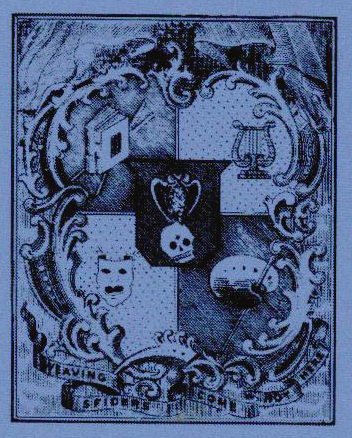
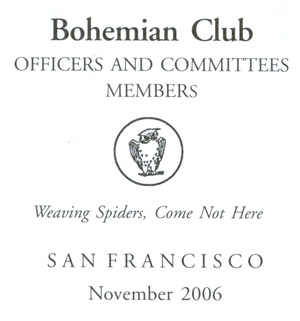
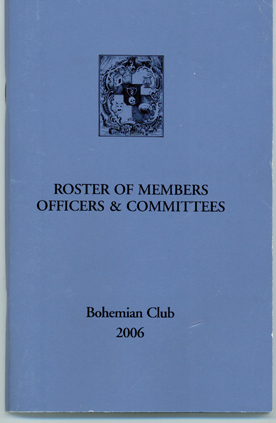
| Blair to attend Bohemian Grove This Weekend?
Date: Sat, 29 Jul 2006 Will Tony Blair attend Bohemian Grove This Weekend? Steve Watson / Prisonplanet | July 29 2006 This weekend sees the finale of the annual gathering of the Bohemian Club in the secluded redwoods about 75 miles north of San Francisco. It just so happens that Tony Blair will be in San Francisco all weekend along with a whole host of other powerful elite luminaries. Whilst the world seems to be on the brink of major war, Blair is, as reported today by the London Independent, on a flying tour of California to meet and do private business with Rupert Murdoch.
The
San Francisco Chronicle reports:
The Tony, private event, a five-day
management retreat for 250 executives of Rupert Murdoch's News Corp., is
set to bring together a VIP guest list for the ages to chat about issues
like volunteerism, technology and politics. Among them: Blair, Israeli
Vice Premier Shimon Peres, former President Bill Clinton, former Vice
President Al Gore, former House Speaker Newt Gingrich, Oakland A's
general manager Billy Beane, former Harvard University President
Lawrence Summers and even U2 lead singer and international do-gooder
Bono.
Introducing Blair to
the crowd on Sunday evening will be California Gov. Arnold
Schwarzenegger. The Republican governor will be celebrating his birthday
and is expected to be on hand with first lady Maria Shriver at the event
sponsored by Murdoch, a generous donor to the GOP whose mega-corporation
owns Fox News, 20th Century Fox, DirecTV and 175 newspapers worldwide --
including the New York Post -- with a total circulation of 40 million.
Whilst in San Francisco Blair will also dine with George and Charlotte
Shultz, the former secretary of state and current state protocol chief,
respectively, and he's also expected to meet with Democratic
gubernatorial nominee Phil Angelides.
Clinton,
Shultz, Gore and Gingrich have all reportedly visited Bohemian Grove on
previous occasions. The SF Chronicle also reported that
Schwarzenegger was hand picked to become California
Governor in 2003 at the Grove.
Could Blair
and his friends be popping by the Redwoods for a visit this year? The
timing of the gathering with Murdoch is very convenient.
The Grove hosts the Bohemian Club every year, members include George H.W.
Bush, Charles Schwab and Walter Cronkite. It has been reported by major
publications in the past that world policy is discussed at the Grove in
between frolicking naked, urinating on trees and engaging in bizarre
Paganistic rituals.
In 2000 Alex
Jones infiltrated the gathering and
caught exclusive video footage of a bizarre
mock human sacrifice ritual, known as "the cremation of
care", under a 40 foot stone owl that the members refer to as
Molech.
Former
President Richard Nixon is
on record discussing homosexual activity at the Grove,
whilst it is also documented that male and female
porn stars and prostitutes are shipped in for the annual
retreat.
We have previously reported that Tony Blair and his wife
are "obsessed" with new age practices and ceremonies and have in the
past according to the London Guardian, attended Aztec Re-birthing
rituals.
Furthermore,
according to the London Times, Blair has made major political decisions
based on new age readings of a hidden force called 'The Light'.
|
|
Bohemian Grove Roster Sent
Anonymously to Infowars Aaron Dykes / JonesReport | June 22, 2007 An interesting package came into the Infowars mailbox recently-- sent anonymously with no return address-- but the contents revealed the reason for secrecy. Someone has shipped our office the 2006 membership roster for the secretive and exclusive Bohemian Grove, which Alex Jones infiltrated and exposed in 2000. A number of high profile elites appear on the list, including David Rockefeller (and son), Henry Kissinger, George H.W. Bush, Gerald Ford, David Gergen (who Alex Jones confronted about his grove membership), Colin Powell, George P. Shultz, Donald Rumsfeld and even Kenneth Starr, who gained attention after prosecuting Bill Clinton. See a 1981 news report on the grove. Many U.S. Presidents have gone to the grove, but most do not appear on the membership roster, though we know that Reagan, Nixon (both pictured below at the Grove), George W. Bush, Herbert Hoover and many other presidents have also attended but are not listed, as is the case for presidential advisor Karl Rove. Claremont-McKenna, (Jack L. Stark),Pepperdine University (Charles B. Runnels, Kenneth W. Starr), CA Institute of Technology (David Baltimore, Charles Elachi), U.S.C. (Shelton Berg, Michael L. Garrett, Brian E. Henderson, M.D. [School of Medicine], Stephen J. Ryan, Steven B. Sample), Scripps College, Claremont, CA (John H. Chandler [member since 1983), U.C. Irvine (Robert C. Combs), U.C. Davis (Arthur H. Smith, Lloyd H. Smith, Jim L. Sochor [Emeritus], Joe P. Tupin, Larry N. Vanderhoef, Julian R. Youmans), University of the Pacific (Donald V. De Rosa), California Academy of Science (Robert C. Drewes), U.C. Hastings School of Law (Geoffrey C. Hazard, William T. Hutton, Frederick W. Lambert, Stephen A. Lind), U.C. Santa Barbara (Robert A. Huttenback), University of California (Hugh D. McNiven, Rudi Schmid), Scripps Institute, UCSD (Charles F. Kennel), CA Academy of Sciences (John P. Kociolek), UCLA (James Q. Wilson [also Harvard emeritus]), U.C. San Francisco (Jay A. Levy, Robert G. Miller, Ronald D. Miller, William R. Murray, Stanley B. Prusiner, Arthur N. Thomas), University of San Francisco (John LoSchiavo, John P. Schlegel), SF State University (John E. McCosker, Arthur Mejia), S.F. Conservatory of Music (Colin Murdoch), Cal State University (Ward M. McAfee), Harvey Mudd College (Joseph Platt), U.C. San Diego (Kirk L. Peterson), Santa Clara University (Peter O'Malley Pierson) UNIVERSITIES OTHER THAN IN CALIFORNIA: Princeton University (Orley Clark Ashenfeler), Universit of WA (Thomas L. Bosworth, Edward D. Verrier), Yale Uninversity (Gerad N. Burrow), University of Calgary (Barry Cooper), Vermont Law School (Douglas M. Costle), Bates College, ME (Edward S. Harwood), Universite Paris (Bertrand Jacquillat), University VA Law School (Charles W. Johnson), Sante Fe Institute (Edward A. Knapp), University of Texas (Bobby Ray Inman, Darwin R. Labarthe, Jeffrey C. Smith), University of Maryland (John Lenczowski), University of Nevada-Reno (Warren L. Lerude), Morehouse College (Walter E. Massey), Howard University (Kurt L. Schmoke), Rockefeller University (Frederick Seitz [labeled as "old guard"; obtained membership in 1966], Wake Forest University (James F. Toole), Duke University Law School (Francis E. McGovern), University of North Carolina (David F. Merten), Amherst College (Joseph G. Moore), Syracuse University (Sean O'Keefe), Columbia University (Ralph M. Richart), Middlebury College (John Spencer), Oberlin College (S. Frederick Starr), George Mason University, VA (Walter E. Williams) The list of notables also includes a number of foreign dignitaries and heads of institutes throughout the U.S. and abroad. Notable Bohemian Grove member Helmut Schmidt, who wrote about his love for the club in his autobiography, Men and Powers, is not listed in 2006 volume. Institute of International Education (founded in 1919, in the same time-frame of the League of Nations and the C.F.R.) (Richard M. Krasno) One of the world's foremost oceanographers, Robert D. Ballard-- who made his name investigating the wreckage of the Titanic, the Bismarck and other famous ships, is listed as representing the Woods Hole Oceanographic Institute, a member since September 12, 1991. Robert Berj Gagosian also represents Wood Hole. Bobby Ray Inman, former head of the NSA and defamed candidate for Secretary of Defense under Clinton, now at the University of Texas LBJ School of Public Affairs in Austin, TX. Christopher C. DeMuth of the American Enterprise Institute in Washington, D.C. Edwin J. Feulner, Jr. and Edwin Meese III of The Heritage Foundation. James A. Kelly of the Pacific Forum CSIS in Honolulu. Consul General of Japan, Makoto Yamanaka Dennis M. Power, Director of the Oakland Museum Fmr. Surgeon General of the U.S., Richard Carmona (term: 2002-July 2006) Consular Mexico - Alfonso de Maria y Campos The Consul General of Luxembourg, Robert Biwer. Also, the Indian Ambassador to the U.S., K Shankar Bajpai (Jan 25, 1968), also a CFR member.
I've also included the so-called 'LIST OF FIFTY' a list honoring regular attendees, though few of the names stand out on first pass. 'Honorary Associates' and 'Honorary Regulars' are also distinguished in the 104-page directory with thousands of names. Notably, in addition to the anonymous shipping of this directory, Alex Jones received a call at his home from the BOHEMIAN GROVE, which was listed on caller-id, but no one identified themselves. It is not clear if this member roster was sent by an employee of the Grove, a member or came to this office through other means.
|
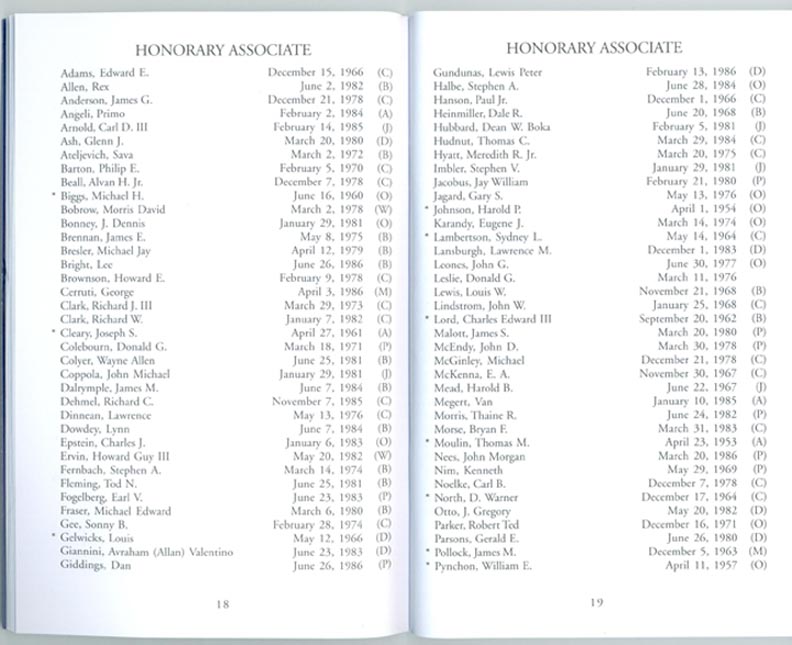
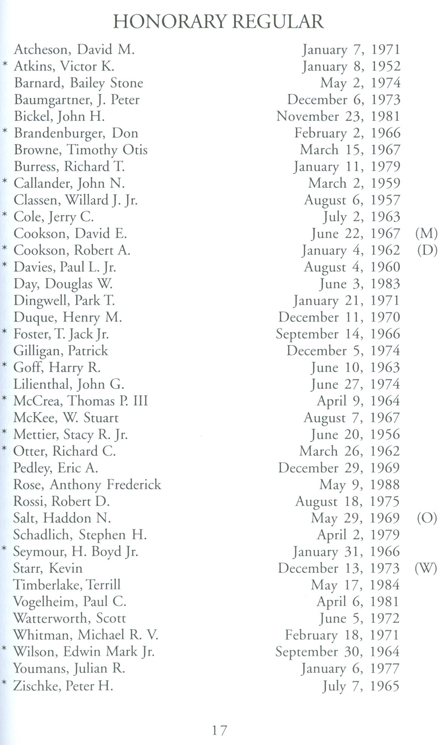
25 Years of Protest at Bohemian Grove
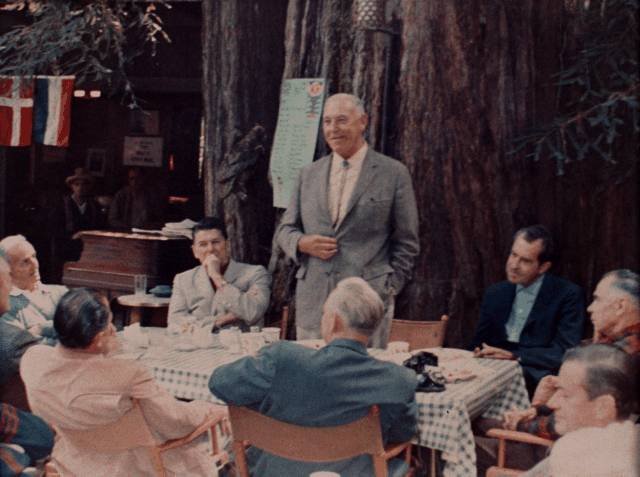
BOHEMIAN GROVE - 1947
DO YOU RECOGNIZE THE FACES ABOVE?
Former Presidents Reagan and Nixon at Bohemian Grove
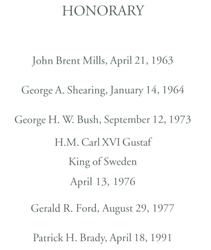
|
Walter Cronkite, the infamous and notable TV journalist, is also a member and listed in the directory. The 'P' next to his name denotes "Regular - Professional." Also listed is the King of Sweden, Carl XVI Gustaf. |

Walter Cronkite

David Gergen

Henry Kissinger

Gen. Colin Powell
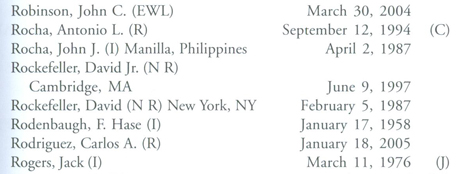
David Rockefeller
David Rockefeller, Jr.

Donald Rumsfeld

George Schultz
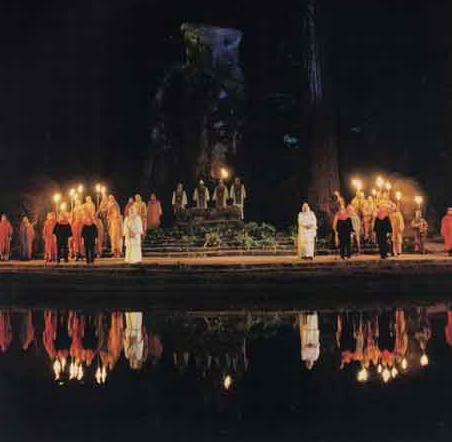
THE CEREMONY
BACKGROUND
July 15, 16 & 17, 2005 will mark twenty five years of protest at the exclusive mens only club, Bohemian Grove in Monte Rio along the Russian River.
In 1980 a small Sonoma county based group, SONOMoreAtomics, began researching some of the corporations that were profiting from nuclear power and weapons. Since Bohemian Grove was located in their backyard they began a protest to make the connections between the top elite of the corporate, banking, military and governmental circles. Within a week through contacts inside the Grove they obtained a membership and guest list and the serious research began. That same year a reporter from MOTHER JONES magazine made contact and the protesters helped him to get inside. By 1981 national attention had been called to this once-secret gathering through articles in MOTHER JONES and PARADE MAGAZINE (Jack Anderson).
By July of 1981 a network of 81 peace, environmental, and justice groups had formed a coalition called BOHEMIAN GROVE ACTION NETWORK which has called attention to this elite network of the "good old boys" for the past 25 years. Special attention has been given to the daily LAKESIDE TALKS which have included presidents, CEO's of the Fortune 500, head of the World Bank, and assorted military leaders."In reality these are public policy talks given without public scrutiny," said Mary Moore, co-founder of BGAN.
On July 15, 2005, the incoming Bohemians will be greeted at the gates as they arrive for the first weekend of their two-week summer encampment. On Saturday, July 16, on the day that the Bohemians CREMATE DULL CARE, the protesters will be at the gates to hold their 25th annual RESURRECTION OF CARE. On Sunday, July 17, a convergence of activists will take place in the Monte Rio amphitheater to network and strategize.
This year's protest is organized by the California State Greens and endorsed by various social activist groups and individuals.
Contact Information
For Background:
Mary K. Moore (707) 874-2248
For Protest Logistics:
Don Eichelberger (415) 567-4577
Paul Encimer (707) 540-9061
See: http://www.sonomacountyfreepress.com/bohos/25years.html
The August 2, 1982 edition of Newsweek magazine reported: "... the world's most prestigious summer camp - the Bohemian Grove - is now in session 75 miles north of San Francisco. The fiercely guarded, 2,700 acre retreat is the country extension of San Francisco's all-male ultra-exclusive Bohemian Club to which every Republican President since Herbert Hoover has belonged.
With its high-powered clientele, coveted privacy and cabalistic rituals, the Bohemian Grove has prompted considerable suspicion. ... The most important events, however are the "lakeside talks" (past orators: Alexander Hague and Casper Weinberger). This year's speaker was Henry Kissinger on The Challenge of the '80s."
Maclean's magazine, March 23, 1981 reported: "Each summer, for three weekends - this year's will be the 103rd - nearly 2,000 Bohemians, with guests in tow, speed in by car and corporate jet to their guarded Grove, close by the hamlet of Monte Rio (population 1,200) on the Russian River. The Grove's Shakespearean motto, "Weaving spiders come not here," is an injunction to forget wheeling and dealing which is widely ignored. While 'ruling-class cohesiveness' rarely lets slip details of accommodations arrived at there, some - such as the 1967 agreement by Ronald Reagan, over a drink with Richard Nixon, to stay out of the coming presidential race - have helped mold America's destiny.
... Oddly enough, reporters are barred from this club, formed one night in 1872 by five bored news hawks on the old San Francisco Examiner to promote good fellowship (i.e., booze-ups) and 'to help elevate journalism to that place in the popular estimation to which it is entitled.' That aspiration went down the drain when membership was extended to show people, and by 1878, the year of the first Grove-fest, the journalist were already on their way out.
Today, a prospective member faces an interrogation that, according to one club man, 'would satisfy the KGB.' There is a waiting list of 1,500 notables, all eager to pay the $2,500 initiation fee and $600 a year dues.
Mother Jones, August 1981 volume 6 page 28, reported a partial list of some of the prominent members: "George P. Shultz, Stephen Bechtel, Jr., Gerald R. Ford, Henry Kissinger, William F. Buckley, Jr., Fred L. Hartley, Merv Griffin, Thomas Haywood, Joseph Coors, Edward Teller, Ronald Reagan, A. W. Clausen, George Bush, William French Smith, John E. Swearingten, Casper W. Weinberger, Justin Dart, William E. Simon, and hundreds of other prominent politicos and businessmen."
Antony C. Sutton, Editor of an excellent monthly newsletter, Phoenix Letter, stated in the October, 1996 edition:
"Up to a few months ago, our knowledge of Bohemian Grove, the exclusive elitist hideaway by supposedly adult wheeler dealers, a.k.a. Washington statesman and prominent people (all male.)
We dismissed the behavior as immature, even pitiful by emotionally disturbed juveniles and not worth attention. This is where Kissinger, Ford, Nixon, Bechtel, Bush, Cheney, Hoover and their friends (2600 members) hang out and "relax." And if they want to behave as little boys that is their privilege, it is private property.
Recent [O'Brien and Phillips, TRANCE Formation of America (pp 170-1)] information may radically change this perception of Bohemian Grove. Not merely drunkenness, unbounded use of alcohol and drugs with vague homosexual tones (confirmed by our sources) but reported activities much more serious - kidnapping, rape, pedophilia, sodomy, ritual murder. Investigation is blocked under the 1947 National Security Act. (!) And like the Omaha child abuse case, includes illegal detention of children.
For decades, there have been vague rumors of weird goings on in Bohemian Grove in more remote parts of its 2200 acres. Reliable reports claim Druidic like rituals, druids in red hooded robes marching in procession and chanting to the Great Owl (Moloch.) A funeral pyre with "corpses." (Scores of men work in the Bohemian Grove as servants so this party is fairly well established.)
An article in a local community newspaper, Santa Rosa Sun (1993, July) reported on the Cult of Canaan and the legend of Moloch in place at Bohemian Grove. The Moloch Pagan Cult of Sacrifice is human sacrifice. About the mid 1980s there were rumors of murders in remote parts of the property. A local police investigation went nowhere. State investigators on related criminal acts went nowhere.
According to an observer and near victim, who can describe the Bohemian Grove inner hideaways, the closed sanctum, even the decor at secret locations, places where no outsider goes (or servants according to our sources) there is an UNDERGROUND lounge (sign spelled U.N.derground) a Dark Room, a Leather Room and a Necrophilia Room.
Here is one of O'Brien's quote "Slaves of advancing age or with failed programming were sacrificially murdered at random in the wooded grounds of Bohemian Grove and I felt it was only a matter of time until it would be me."
This potential victim survived. Others reportedly did not.
The Origin of Moloch, Druid and Canaanite Cult
These cults were based on human sacrifice. Why would a 20th century resort reproduce the cult ceremonies? At the minimum, it demonstrates an attraction to the ceremonial practices of the cult, i.e. adoration of destruction, blood, barbarity and sacrifice of children.
In brief, the O'Brien charges are consistent with the tenants of Bohemian Grove as played out in ceremony. This is not a resort devoted to, for example, tennis or swimming. It is apparently devoted to blood sacrifices.
John Milton in Paradise Lost described Moloch as follows:
"First Moloch, horrid king, besmirched with blood
Of human sacrifice, and parents' tears,
Though, for the noise of drums and timbrels loud,
Their children's cries unheard, that passed through fire
To his grim idol."
"Many political reputations and world governments secrets were staked on the belief that I could not be deprogrammed and rehabilitated to recall that which I was supposed to forget."
So much for the programming experts. Colonel Aquino is a psychology "expert" linked to mind control with Defense Intelligence Agency and presumably first class talent, yet (Cathy) O'Brien was apparently deprogrammed and secrets spilled all over." (end quoting)
The monthly Phoenix Letter is available by writing to Phoenix Letter, Suite 216 C, 1517 14th St. West, Billings, MT 59102.
The book "TRANCE Formation of America" is an autobiography by Cathy O'Brien with Mark Phillips. Cathy and her 8 year old daughter were rescued from their mind-controlled existence in 1988 and taken to Alaska by Mark Phillips for safety and rehabilitation. She and her daughter were victims of the US Government Defense Intelligence Agency TOP SECRET MK-Ultra Project Monarch (MIND CONTROL). Cathy became a White House "Presidential Model" Mind-control slave. Later on, her very young daughter was included in this evil MIND CONTROL project, and was physically, sexually and mentally tortured by the pen-stripe suited leaders of the most powerful organization in the world, our US Government. I will not take this space to tell you the entire story, because it is much more alarming as it is related by Cathy in this VERY DISTURBING book. My first reaction to reading these facts was utter sadness to learn about two innocent human beings that were tortured and treated as simple tools for the pleasure of our world leaders. This was followed by extreme anger, when I realized that the persons committing these horrible crimes were not repeat offenders who were just recently released from a maximum security prison or mental hospital, but people who are our recent and current elected and appointed state and federal leaders. If this book does not deeply sadden you, and then make you very angry, you just don't understand.
As these world leaders, who have all the creature comforts that they could ever desire, look around for something new and interesting to do to amuse themselves, is it not reasonable to assume that they eventually will revert to pagan ritual rites, mind control, pedophilia, necrophilia, homosexuality, bestiality, prostitution and yes - human sacrifice? Apparently they already have!!
Alex Jones, a patriot friend from Austin, Texas had the guts to sneak into the Bohemian Grove a couple of years ago with a video camera. He secretly filmed about an hour of the Medieval rituals performed before the 40-foot high concrete owl that they were worshiping. One of the rituals was a sham burning of a human being on the altar in front of the owl. Others have reported in the past that they have sacrificed live human beings on this altar. You can purchase a copy of this VHS video tape by going to Alex's web site at http://www.infowars.com/bg1.html
Date: Sunday, 18 July 2004, 6:01 p.m.
2000 Rich And Powerful Arrive Secretly At Bohemian Grove
Free Press International
7.18.2004Some 2000 CEO's, government officials and movies stars landed at the Sonoma County Airport in Santa Rosa, California yesterday to attend the secret 2004 Bohemian Grove Meeting just outside Monte Rio, CA. The press is not invited to Bohemian Grove. Sentries scan the paths from above with binoculars, helped out by infrared sensors.
There are 125 different camps such as Toyland, Dog House, Sons of Toil and Mandalay Effect. George H.W. Bush will be in Hill Billies camp, along with Defense Secretary Donald Rumsfeld according to the San Francisco Chronicle.
The Hearst family were members of Bohemian Grove but the Hearst-owned Examiner ran a 1901 piece in which Ambrose Bierce predicted the assassination of President William McKinley. He was assassinated soon after.
Edward Teller and others in the Manhattan Project mapped out the atomic bomb in the autumn of 1942 at Bohemian Grove.
The grove is the site of a two week retreat every July (as well as other smaller get-togethers throughout the year). At these retreats, the members commune with nature in a truly original way. They drink heavily from morning through the night, bask in their freedom to urinate on the redwoods, and perform pagan rituals (including the "Cremation of Care", in which the members wearing red-hooded robes, cremate a coffin effigy of "Dull Care" at the base of a 40 foot owl altar). Some (20%) engage in homosexual activity (but few of them support gay rights or AIDS research). They watch (and participate in) plays and comedy shows in which women are portrayed by male actors. Although women are not allowed in the Grove, members often leave at night to enjoy the company of the many prostitutes who come from around the world for this event. Is any of this hard to believe? Employees of the Grove have said that no verbal description can accurately portray the bizarre behavior of the Grove's inhabitants.
Besides this type of merriment. the annual gathering serves as an informational clearing house for the elite. The most powerful men in the country do their "networking" here, despite the Grove's motto "weaving spiders come not here" (don't do business in the Grove). At these gatherings men representing the government, military-industrial, and financial sectors meet and make major policy decisions. The Manhattan project, which produced the first atomic bombs, was conceived at the Grove in 1942. Other decisions made at the Grove include who our presidential candidates will be. There are speeches, known as "Lakeside Talks", wherein high-ranking officials disseminate information which is not available to the public-at-large.
When powerful people work together, they become even more powerful. The Grove membership is wealthy, and becoming more so, while the middle class is steadily becoming poorer. This close-knit group determines whether prices rise or fall (by their control of the banking system, money supply, and markets), and they make money whichever way markets fluctuate. They determine what our rights are and which laws have effect, by appointing judges. They decide who our highest officials shall be by consensus among themselves, and then selling candidates to us via the media which they own. Important issues and facts are omitted from discussion in the press, or slanted to suit their goals, but they are discussed frankly at the Grove. Is there true democracy when so much power is concentrated in so few hands? Is there any real difference between the public and private sectors when cabinet members come from the boardrooms of large corporations? Is the spending of billions on weapons, which are by consensus no longer needed, really the will of the people? Or is it the will of General Electric, General Dynamics, and the other weapons contractors represented at the Grove?
FROM: http://www.sonomacountyfreepress.com/bohos/bohofact.html
See: http://www.sonomacountyfreepress.com/bohos/25years.html
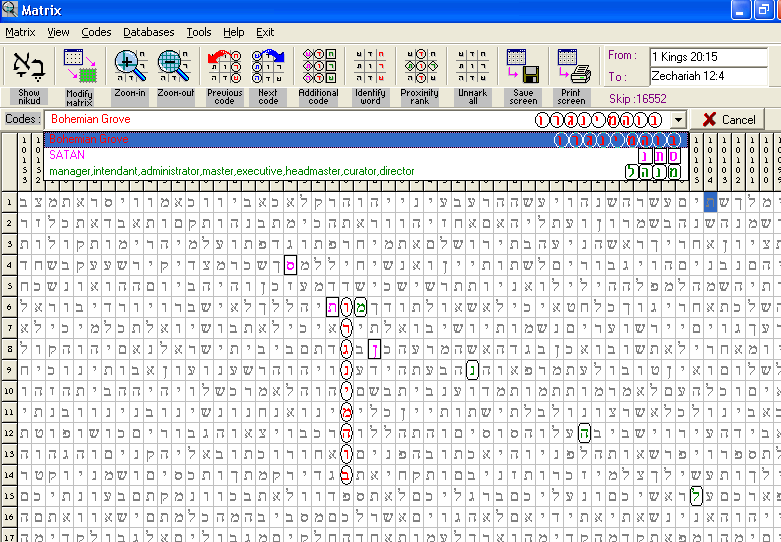
SATAN HEADMASTER
FROM: http://www.hiddencodes.com/grove.htm
The August 2, 1982 edition of Newsweek magazine reported: "... the world's most prestigious summer camp - the Bohemian Grove - is now in session 75 miles north of San Francisco. The fiercely guarded, 2,700 acre retreat is the country extension of San Francisco's all-male ultra-exclusive Bohemian Club to which every Republican President since Herbert Hoover has belonged.
With its high-powered clientele, coveted privacy and cabalistic rituals, the Bohemian Grove has prompted considerable suspicion. ... The most important events, however are the "lakeside talks" (past orators: Alexander Hague and Casper Weinberger). This year's speaker was Henry Kissinger on The Challenge of the '80s."
Maclean's magazine, March 23, 1981 reported: "Each summer, for three weekends - this year's will be the 103rd - nearly 2,000 Bohemians, with guests in tow, speed in by car and corporate jet to their guarded Grove, close by the hamlet of Monte Rio (population 1,200) on the Russian River. The Grove's Shakespearean motto, "Weaving spiders come not here," is an injunction to forget wheeling and dealing which is widely ignored. While 'ruling-class cohesiveness' rarely lets slip details of accommodations arrived at there, some - such as the 1967 agreement by Ronald Reagan, over a drink with Richard Nixon, to stay out of the coming presidential race - have helped mold America's destiny.
... Oddly enough, reporters are barred from this club, formed one night in 1872 by five bored news hawks on the old San Francisco Examiner to promote good fellowship (i.e., booze-ups) and 'to help elevate journalism to that place in the popular estimation to which it is entitled.' That aspiration went down the drain when membership was extended to show people, and by 1878, the year of the first Grove-fest, the journalist were already on their way out.
Today, a prospective member faces an interrogation that, according to one club man, 'would satisfy the KGB.' There is a waiting list of 1,500 notables, all eager to pay the $2,500 initiation fee and $600 a year dues.
Mother Jones, August 1981 volume 6 page 28, reported a partial list of some of the prominent members: "George P. Shultz, Stephen Bechtel, Jr., Gerald R. Ford, Henry Kissinger, William F. Buckley, Jr., Fred L. Hartley, Merv Griffin, Thomas Haywood, Joseph Coors, Edward Teller, Ronald Reagan, A. W. Clausen, George Bush, William French Smith, John E. Swearingten, Casper W. Weinberger, Justin Dart, William E. Simon, and hundreds of other prominent politicos and businessmen."
Antony C. Sutton, Editor of an excellent monthly newsletter, Phoenix Letter, stated in the October, 1996 edition:
"Up to a few months ago, our knowledge of Bohemian Grove, the exclusive elitist hideaway by supposedly adult wheeler dealers, a.k.a. Washington statesman and prominent people (all male.)
We dismissed the behavior as immature, even pitiful by emotionally disturbed juveniles and not worth attention. This is where Kissinger, Ford, Nixon, Bechtel, Bush, Cheney, Hoover and their friends (2600 members) hang out and "relax." And if they want to behave as little boys that is their privilege, it is private property.
Recent [O'Brien and Phillips, TRANCE Formation of America (pp 170-1)] information may radically change this perception of Bohemian Grove. Not merely drunkenness, unbounded use of alcohol and drugs with vague homosexual tones (confirmed by our sources) but reported activities much more serious - kidnapping, rape, pedophilia, sodomy, ritual murder. Investigation is blocked under the 1947 National Security Act. (!) And like the Omaha child abuse case, includes illegal detention of children.
For decades, there have been vague rumors of weird goings on in Bohemian Grove in more remote parts of its 2200 acres. Reliable reports claim Druidic like rituals, druids in red hooded robes marching in procession and chanting to the Great Owl (Moloch.) A funeral pyre with "corpses." (Scores of men work in the Bohemian Grove as servants so this party is fairly well established.)
An article in a local community newspaper, Santa Rosa Sun (1993, July) reported on the Cult of Canaan and the legend of Moloch in place at Bohemian Grove. The Moloch Pagan Cult of Sacrifice is human sacrifice. About the mid 1980s there were rumors of murders in remote parts of the property. A local police investigation went nowhere. State investigators on related criminal acts went nowhere.
According to an observer and near victim, who can describe the Bohemian Grove inner hideaways, the closed sanctum, even the decor at secret locations, places where no outsider goes (or servants according to our sources) there is an UNDERGROUND lounge (sign spelled U.N.derground) a Dark Room, a Leather Room and a Necrophilia Room.
Here is one of O'Brien's quote "Slaves of advancing age or with failed programming were sacrificially murdered at random in the wooded grounds of Bohemian Grove and I felt it was only a matter of time until it would be me."
This potential victim survived. Others reportedly did not.
The Origin of Moloch, Druid and Canaanite Cult
These cults were based on human sacrifice. Why would a 20th century resort reproduce the cult ceremonies? At the minimum, it demonstrates an attraction to the ceremonial practices of the cult, i.e. adoration of destruction, blood, barbarity and sacrifice of children.
In brief, the O'Brien charges are consistent with the tenants of Bohemian Grove as played out in ceremony. This is not a resort devoted to, for example, tennis or swimming. It is apparently devoted to blood sacrifices.
John Milton in Paradise Lost described Moloch as follows:
"First Moloch, horrid king, besmirched with blood
Of human sacrifice, and parents' tears,
Though, for the noise of drums and timbrels loud,
Their children's cries unheard, that passed through fire
To his grim idol."
"Many political reputations and world governments secrets were staked on the belief that I could not be deprogrammed and rehabilitated to recall that which I was supposed to forget."
So much for the programming experts. Colonel Aquino is a psychology "expert" linked to mind control with Defense Intelligence Agency and presumably first class talent, yet (Cathy) O'Brien was apparently deprogrammed and secrets spilled all over." (end quoting)
The monthly Phoenix Letter is available by writing to Phoenix Letter, Suite 216 C, 1517 14th St. West, Billings, MT 59102.
The book "TRANCE Formation of America" is an autobiography by Cathy O'Brien with Mark Phillips. Cathy and her 8 year old daughter were rescued from their mind-controlled existence in 1988 and taken to Alaska by Mark Phillips for safety and rehabilitation. She and her daughter were victims of the US Government Defense Intelligence Agency TOP SECRET MK-Ultra Project Monarch (MIND CONTROL). Cathy became a White House "Presidential Model" Mind-control slave. Later on, her very young daughter was included in this evil MIND CONTROL project, and was physically, sexually and mentally tortured by the pen-stripe suited leaders of the most powerful organization in the world, our US Government. I will not take this space to tell you the entire story, because it is much more alarming as it is related by Cathy in this VERY DISTURBING book. My first reaction to reading these facts was utter sadness to learn about two innocent human beings that were tortured and treated as simple tools for the pleasure of our world leaders. This was followed by extreme anger, when I realized that the persons committing these horrible crimes were not repeat offenders who were just recently released from a maximum security prison or mental hospital, but people who are our recent and current elected and appointed state and federal leaders. If this book does not deeply sadden you, and then make you very angry, you just don't understand.
As these world leaders, who have all the creature comforts that they could ever desire, look around for something new and interesting to do to amuse themselves, is it not reasonable to assume that they eventually will revert to pagan ritual rites, mind control, pedophilia, necrophilia, homosexuality, bestiality, prostitution and yes - human sacrifice? Apparently they already have!!
Alex Jones, a patriot friend from Austin, Texas had the guts to sneak into the Bohemian Grove a couple of years ago with a video camera. He secretly filmed about an hour of the Medieval rituals performed before the 40-foot high concrete owl that they were worshiping. One of the rituals was a sham burning of a human being on the altar in front of the owl. Others have reported in the past that they have sacrificed live human beings on this altar. You can purchase a copy of this VHS video tape by going to Alex's web site at http://www.infowars.com/bg1.html
Date: Sunday, 18 July 2004, 6:01 p.m.
2000 Rich And Powerful Arrive Secretly At Bohemian Grove
Free Press International
7.18.2004Some 2000 CEO's, government officials and movies stars landed at the Sonoma County Airport in Santa Rosa, California yesterday to attend the secret 2004 Bohemian Grove Meeting just outside Monte Rio, CA. The press is not invited to Bohemian Grove. Sentries scan the paths from above with binoculars, helped out by infrared sensors.
There are 125 different camps such as Toyland, Dog House, Sons of Toil and Mandalay Effect. George H.W. Bush will be in Hill Billies camp, along with Defense Secretary Donald Rumsfeld according to the San Francisco Chronicle.
The Hearst family were members of Bohemian Grove but the Hearst-owned Examiner ran a 1901 piece in which Ambrose Bierce predicted the assassination of President William McKinley. He was assassinated soon after.
Edward Teller and others in the Manhattan Project mapped out the atomic bomb in the autumn of 1942 at Bohemian Grove.
The grove is the site of a two week retreat every July (as well as other smaller get-togethers throughout the year). At these retreats, the members commune with nature in a truly original way. They drink heavily from morning through the night, bask in their freedom to urinate on the redwoods, and perform pagan rituals (including the "Cremation of Care", in which the members wearing red-hooded robes, cremate a coffin effigy of "Dull Care" at the base of a 40 foot owl altar). Some (20%) engage in homosexual activity (but few of them support gay rights or AIDS research). They watch (and participate in) plays and comedy shows in which women are portrayed by male actors. Although women are not allowed in the Grove, members often leave at night to enjoy the company of the many prostitutes who come from around the world for this event. Is any of this hard to believe? Employees of the Grove have said that no verbal description can accurately portray the bizarre behavior of the Grove's inhabitants.
Besides this type of merriment. the annual gathering serves as an informational clearing house for the elite. The most powerful men in the country do their "networking" here, despite the Grove's motto "weaving spiders come not here" (don't do business in the Grove). At these gatherings men representing the government, military-industrial, and financial sectors meet and make major policy decisions. The Manhattan project, which produced the first atomic bombs, was conceived at the Grove in 1942. Other decisions made at the Grove include who our presidential candidates will be. There are speeches, known as "Lakeside Talks", wherein high-ranking officials disseminate information which is not available to the public-at-large.
When powerful people work together, they become even more powerful. The Grove membership is wealthy, and becoming more so, while the middle class is steadily becoming poorer. This close-knit group determines whether prices rise or fall (by their control of the banking system, money supply, and markets), and they make money whichever way markets fluctuate. They determine what our rights are and which laws have effect, by appointing judges. They decide who our highest officials shall be by consensus among themselves, and then selling candidates to us via the media which they own. Important issues and facts are omitted from discussion in the press, or slanted to suit their goals, but they are discussed frankly at the Grove. Is there true democracy when so much power is concentrated in so few hands? Is there any real difference between the public and private sectors when cabinet members come from the boardrooms of large corporations? Is the spending of billions on weapons, which are by consensus no longer needed, really the will of the people? Or is it the will of General Electric, General Dynamics, and the other weapons contractors represented at the Grove?
FROM: http://www.sonomacountyfreepress.com/bohos/bohofact.html
Some of this information is repetitive but worth reading: Bohemian Grove Employee Blows the Whistle on Inside Events
Steve Watson & Alex Jones | September 29 2005
Prisonplanet.tv click here for the full interview
Yesterday Alex Jones was joined on air by a guest who worked inside Bohemian Grove and got up close and personal with the macabre rituals of the elite and their homosexual tendencies. These new revelations have been heard nowhere else.
"Kyle" has worked at the Grove for their Spring Jinx for the "neophytes", the newcomers or outsiders, and for the official fifteen day Summer encampment festival.
The Grove is a private 2,700 acre redwood retreat on the Russian River in Sonoma County, California. Described as the "Greatest Men's Party on Earth," the members of the Bohemian Club and international elites have been gathering in their redwoods for over 100 years. Regular visitors include the Bushes, Henry Kissinger, Colin Powell, Newt Gingrich, whilst past luminaries have included Former Presidents Regan and Nixon, together BEFORE they had even taken office.
The most famous ritual that occurs at the Grove every year is the Symbolic Pagan Worship of Molech–the ‘god’ of Child Sacrifice. A bound effigy is burned in a "Cremation of Care" ceremony under a 40ft Stone Owl. Remember that political figureheads from around the world attend this sacrifice ceremony. German Chancellor Helmut Schmidt wrote of his fondness for the Grove ceremonies in his Biography "Men and Power". If your neighbours were doing this in their back yard wouldn't you be slightly concerned? These people are making decisions that have global repercussions.
The Camp at the Grove is riddled with imagery of death, sacrifice, skulls and Owls, as is the Club's Headquarters in San Francisco.
This all sounds bizarre and incredible, you couldn't make it up. Yet we have seen again and again how elite figures are obsessed with these kinds of activities. We have a full archive and Alex has infiltrated and made a full length feature film on the occult rituals that take place on an annual basis at the elite hideaway at the Bohemian Grove.
There are many offshoots of the Bohemian Club, The most famous US branch is the "Brotherhood of Death" known as Skull and Bones, members of which include Both Bushes and recent Democratic nominee John kerry.
In the past members have bragged about how far reaching plans are hatched and policies set within the grove, such as the Star Wars defense initiative and the Manhattan Project.
"Kyle" went on record as saying he witnessed Colin Powell, Justice Clarance Thomas, Governor of New Mexico Bill Richardson all in attendance at this year's encampment.
The most honored guests reside in one of 119 camps known as Mandalay and rarely venture down to the dining circle of the Grove. Even other Grove members are not allowed to go near this camp without an invitation.
"Kyle" entered the Grove, without knowing anyone else in there, after an interview at the Grove in April. Immediately he took the chance to sneak around by driving in beyond the security gate which was at the time unattended. At this point the security was not overwhelming as there were no luminaries inside.
"Kyle" then described driving up to the lake area and getting a close up view of the 40ft Stone Owl.
Upon returning to begin work at the annual "Spring Jinx" "Kyle" witnessed the extensive use of biometric scanning equipment. Employees now have to hand scan to gain entry and to leave the Grove. It seems that security has been stepped up since Alex Jones infiltrated over five years ago. The members are able to forego this scanning and simply have ID cards.
Alex snook in through the undergrowth before the main entrance to the grove. "Kyle" stated that there are now motion sensors all over that area to prevent any new would-be intruders.
"Kyle" described how the employees at the Grove are segregated in separate areas and have to wear different color coded badges.
He then went on to describe how as one of the younger men in there, he was approached numerous times by men in their 50s, 60s and 70s and asked if he "slept around".
We have previously exposed how members of the grove have both male and female prostitutes and even gay porn stars flown in for the Summer camp. Former President Richard Nixon is on record questioning the activities at the Grove, making reference to the debase, decadent attitude as well as the homosexual activity there.
"Kyle" went on to reveal how as well as containing lots of Satanic themed imagery, the Grove is also very Pagan in nature. There is a large statue of the Godess Diana, the main Circle is named Diana, there are buses named Diana, Old Druid and hamadryad (From Greek/Roman mythology - A wood nymph who lives only as long as the tree of which she is the spirit lives or a King Cobra) which is one of the high priests in the Cremation of Care ceremony.
Cremation Of Care Ceremony
"Kyle" described how he managed to find the building in which garb for the main Cremation of Care ceremony was housed. He filmed inside with his small camera with two hands but was so on edge that you can see he is physically shaking.
"Kyle" described how he saw multiple "effigies" for use in the Cremation of Care Ceremony in addition to the one inside the Hollow Stone Owl. There is a body that they drive in on a hearse, one that is rowed across the lake by the grim reaper and a third that is burned in the Molech Owl.
He also described how prior to the ceremony he managed to get inside the Owl and witnessed electrical equipment presumably for use during the ceremony for fireworks or to light the fire and burn the effigy.
According to "Kyle" the Cremation of Care ceremony has altered only slightly since Alex caught it on video. There were some new effects and a different voice over for "care". Previously the voice had been reported as Walter Kronkite, yet "Kyle" reported that Kronkite, one of the "Hillbillies" along with the Bushes was there but was not in good health.
"Kyle" has managed to get around five hours of video and 50 photos in the Grove with the use of a pen camera. This footage will be included in a re-release of Alex's Dark Secrets Inside Bohemian Grove. The first showing of this will be at the Downtown Alamo Drafthouse in Austin on the 9th of October, with a follow up the day after. Get Alex Jones and Paul Joseph Watson's books, ALL Alex's documentary films, films by other authors, audio interviews and special reports.Sign up at Prison Planet.tv - CLICK HERE.
Conspiracies, CoverUps, Truths,
Facts, Oddities, Research
Research Material

KEEPING SECRETS, NOT REPORTING THEM
The founder of USA Today recently gave a speech to 1,500 of this country's most powerful men. What did he tell them? Sorry - it's a secret.
Al Neuharth spoke at Bohemian Grove, the all male encampment in Northern California where much of America's government and corporate elite gathers each summer for two weeks of speeches and activities like mock- Druid fire rituals. The official program described Neuharth's topic as "a look inside media newsrooms and boardrooms." That sounded interesting, so we called and asked for the text of his speech.
The normally talkative Neuharth was tight- lipped. "I went there with the understanding that I would adhere to their privacy rules," he replied. "I think I'd have a little ethical problem giving you the text.... I just don't want to do what they would consider unethical." The program identified Neuharth as chairman of the Freedom Forum - a $700 million foundation dedicated to a "free press." So, why did the head of that foundation agree to get together with other power brokers to deliver speeches when everyone was sworn to secrecy?
The day before his own speech, Neuharth was among 2,200 men who heard an address by House Speaker Newt Gingrich. And what did Gingrich have to say? "I'm sorry," Gingrich staff writer Robert George told us. "We do not have a copy of that speech, and it will not be transcribed.... The Bohemian Grove events are basically private functions."
But matters of great public concern are discussed. The day before Gingrich's speech - with a crucial mass-communications bill gliding through Congress and some humongous media mergers in the offing - a top AT&T executive supplied an assessment of "the complex web of futuristic communications."
A week later, former President George Bush spoke at Bohemian Grove. In fact, every Republican president since Coolidge has been a member. In modern times, participants have included secretaries of state (Henry Kissinger, George Shultz, James Baker), Jimmy Carter, William Randolph Hearst Jr., Walter Cronkite, David Gergen and David Rockefeller. Notables have also included the presidents of CNN and the Associated Press.
All of this gets very little news coverage - a fact that has long frustrated Sonoma County businesswoman Mary Moore, an activist who lives 5 miles from the deluxe camp. Many diligent journalists have tried to report about what goes on. "The problem is," Moore says, "when the story gets to the top board-rooms, then it gets killed." Journalist Dirk Mathison found out the hard way. In July 1991, when Mathison was the San Francisco bureau chief of People magazine (owned by Time Warner), he sneaked into the Grove's 2,700 acre spread three times. On his third foray, Mathison ran into a Time Warner exec who recognized him - and threw him out.
Mathison had already learned a lot. For example, a former secretary of the Navy, John Lehman, presented a lecture stating that the Pentagon estimated 200,000 Iraqis were killed during the Gulf War a few months earlier. The Pentagon believed the public was not ready to hear the death count; at Bohemian Grove, Lehman was more candid.
But Mathison's eyewitness report never made it into the pages of People. Even though Mathison says his article was so well-received that extra space was allotted for it, the story was mysteriously killed.
The Mathison episode illustrates how difficult it can be for journalists to report fully on America's political and economic elite when their bosses are loyal members of that elite.
Jeff Cohen and Norman Solomon are authors of the new book, "Through the Media Looking Glass: Decoding Bias and Blather in the News"
Related Research Material:
Who's Who of the Elite :
Members of the Bilderbergs, Council on Foreign Relations, & Trilateral Commission
by Robert Gaylon Ross Sr.
The Shadows of Power :
The Council on Foreign Relations and the American Decline
by James Perloff
The Occult Conspiracy :
Secret Societies - Their Influence and Power in World History
by Michael Howard
America's Secret Establishment
by Antony C. Sutton
Occult Theocracy
by Lady Queensborough
Secret Societies and Subversive Movements
by Nesta Webster
In Satanic (Like) Rituals
National Geographic On Bohemian Club 1915
What Is The Bohemian Grove?
Bohemian Grove Action Network
VIDEO: Bohemian Grove Rituals 2001
The Truth About Bohemian Grove
The Story People Magazine Won't Let You Read
Trance Formation Of America
Sonoma County Airport - This Is Where Most World Leaders Will Fly Into
Jets Arrive At Bohemian Grove
World Leaders Arrive At Bohemian Grove
Donald Rumsfeld On Bohemian Grove
FILM: Bohemian Grove 1938
Activists Protesting Bohemian Grove On July 18, 2004
President Nixon And Reagan At Bohemian Grove 1967
Future President Eisenhower And Past President Hoover At Bohemian Grove, July 23, 1950.
Reagan: Attended Bohemian Grove Encampment In 1941,1989
Karl Rove At The Grove In 2003
Hewlett Packard And Bohemian Grove
San Francisco Bohemian Club
Old Bohemian Grove Pictures
Pictures
William F. Buckley Jr.
Bohemian Grove 1987
Books On BG
October Surprise
Pictures
The Movie: The Return
Bohemian Grove: White Wedding
Bohemian Grove: Dirty Water
Groovin At The Grove
Belizean Grove Modeled After Bohemian Grove
MUST READ: Our global elite leaders to perform human sacrifices on TV!!!They shall not pass!! Pray for their confounding...
Bohemian Grove Human Sacrifice Ritual To Appear On Cartoon Network
The Occult Rituals of the Global Elite Will Appear on the Cartoon Network this Sunday Night
Outlaw News
October 6, 2007
The Grove as it appears in the cartoon (left) appears to be modeled after the real thing as it appeared in the Alex Jones film, ‘Dark Secrets Inside Bohemian Grove.
Lucy, Daughter of the Devil, is an ‘adult cartoon’, part of the Turner Broadcasting owned Cartoon Network’s late night line-up. It is a 10 minute CGI comedy show; the plot follows an eccentric and im-witted Satan, who is living in San Francisco, trying to convince his 21-year-old daughter, Lucy, to assume her role as the Antichrist. Along the course of their adventures, Lucy meets and begins to court ‘DJ Jesús’, a laid back techno DJ who turns out to be the second coming of Christ. The show is heavy with blasphemous shocks, but as it is sadly lacking it wit, it rates among the lower end shows featured in the ‘Adult Swim’ programming block; without the talents of H. Jon Benjamen, the brilliant voice actor who providing the voice of Satan, the show likely never would have made it past the pilot.
This Sunday an episode of the show entitled ‘Human Sacrifice’ will air, in which the Devil is summoned to attend a ritual human sacrifice at the Bohemian Grove in Northern California, held to honor a senator who has been chosen to be elected as the next president. DJ Jesús is chosen to serve as the sacrificial victim, and is lured to the Grove under the pretext that he will be DJing the ‘most amazing dance party/orgy/political summit on the planet’, which he is told is like the movie ‘Eyes Wide Shut’, except Alan Greenspan and Bono will be there.
The Grove, as it appears in the show, was clearly modeled after actual footage of the site which appeared in Alex Jones’ film ‘Dark Secrets Inside Bohemian Grove’, or from the memory of someone who has attended. The ritual begins with torches lighting up the night, and the crowd, which contains ‘half of Washington’, chanting ‘Hail Satan’. The Devil appears and declares that ‘ten presidents have announced their candidacy in front of this unholy alter’, before introducing a comedian to give a pre-sacrifice routine of poop jokes that the Devil had written for him in exchange for his soul. A bit of cartoon mayhem ensues with DJ Jesús escaping the sacrifice in order to provide the music for the crowd. The show finishes by zooming out of an aerial view of the grove, displaying its real-life location in Northern California.
I have no doubt that many people within the Truth Movement will attempt to claim that this show was intended to somehow ‘expose the elite’, just as they did when South Park made a brutal mockery of 9/11 Truth. I do not believe that this is the case. In recent years we have seen several examples of this type of public display of the occult nature of the ruling elite, all of which, save Kubrick’s ‘Eyes Wide Shut’ and a couple others, have been done through some form of comedy. It is my assertion that orders for this kind of exposure must in some way trickle down from the top, or it would not be allowed at all.
Their motivation in doing this is part of what Alice Bailey called the ‘externalization of the hierarchy’, a process through which those occult masters who have ruled the planet throughout history voluntarily expose themselves and their true nature. This is to be a slow process where we, the public, are gradually familiarized with the concept through the use of gradualism. Comedy shows are the most effective way of doing this, as they put us in such a mood that we are not thinking about what we see in a serious or rational way, and are thus much more susceptible to being familiarized with concepts that would normally evoke fear or revulsion if they were not presented in such a light-hearted manner.
Expect to see more and more of this type of thing in the future.
-Andre
—-
The show can presently be viewed online in it’s entirety at this link.
===================
MUST READ!!!: Global elite leaders expose their real selves to us!
savethemales.ca
Banker Told It Like It IS
By Henry Makow Ph.D.
October 6, 2007
By Henry Makow Ph.D.
( On weekends I will repost notable articles that are more relevant than ever. This is a slightly revised version of an article posted in May 2006.)
Current events are like a "Magic Eye" picture that you have to stare at for a long time. But if you know what to look for, the picture emerges as plain as day.
As incredible and bizarre as this sounds, a satanic (cabalistic) occult society has taken control of the planet through the central banking system. It seeks to impose its tyranny through the ruse of the "war on terror" and "globalization." Every war was a trick used to slaughter and brutalize humanity and to increase the wealth and power of this cabal, which is based in the Bank of England.
Another confirmation of this disturbing truth is a spine-chilling letter that is worth considering periodically. The letter, which surfaced on the Internet a few years ago, dispels any illusions that we are free citizens living in a beneficent democracy. Addressed, from "your globalist friend," the letter advises citizens of the world "you are our property" and must accept servitude "for your own good."
"The days of putting a stop to us have long since past," he writes sounding like Big Brother.
" We have full control of the earth and its finance, along with the major media propaganda, and there is simply no way any nation or power can defeat us... We can send American or European troops to wherever we like, whenever we like, and for whatever purpose we like, and you dutifully go about our business...How much more evidence do you need? ...Does it not seem reasonable that you simply obey and serve us?"
I caution you material like this can induce a kind of schizophrenia because it provides a vision of reality so different from the one we are given by the mass media.
The six-page letter was written in the autumn of 1999 but didn't receive broad circulation.
It could be a hoax but I think it describes our present reality. It is consistent with what many conspiracy researchers have discovered independently, yet more vivid and insightful than anything they could fabricate.
THE LETTER
Our globalist friend says he wants to explain political reality so we "might know how to behave in the New Order now taking shape on the earth."
He exults in the fact that he represents a secret force that controls the world yet is invisible to all.
"We run everything, yet, you do not know who to attack. I must say this hidden hand is wonderfully devised and without any known historical precedent on this scale. We rule the world and the world cannot even find out who is ruling them. This is truly a wonderful thing. In our media we present before you exactly what it is we want you to do. Then, as if in a flash, our little servants obey."
But he does identify himself. He clearly represents the central bankers: "Your own money has served to forge the chains we bind you with, since we are in control of all money."
As I have said, the central banking cartel is the mainspring of the New World Order. By giving foreign private interests the power to create money based on our credit, our predecessors doomed Western Civilization. These private interests naturally bought control of everything and everyone and now want to institutionalize their control globally. This is behind world government and at the heart of the "war on terror."
"Our kingdom is the kingdom of money," our globalist friend writes. "We have given you a piece of paper or some numbers on a computer screen that we have termed 'money.' It is backed up by nothing and proven by nothing but what we say it is. We create it from nothing, we print it, we loan it, we give it its value, and we take its value away. All things that have to do with money are in our hands."
Our globalist friend reveals that the bankers have a symbiotic relationship with us. We produce profits by borrowing from them.
"We want you to be in the system. When you are buying a house, we not only receive the tax revenue to use for our purposes, but we gain large increases from the interest on the loan. You may pay for your house two or three times over from the interest alone. The interest is also taxed which is again placed for use in those sectors of influence we choose. We do not want you to escape free and that is why we have made it as we have."
One of those sectors of influence is education. He says our taxes pay for "the indoctrination of your children in the public schools we have set up. We want them to grow up well trained into the system of our thinking. Your children will learn what we want them to learn, when we want them to learn it, and you pay for it."
"You are our property. We will not permit you to buy or sell unless you submit to our mark of authority. If you go to court against us, we will wear you out there and in the end you will lose. If you use violence, we will end up having you in one of our labor camps, more specifically called prison industries. You need our money, our entertainments, our fuel, and our utilities to function and if you don't have them, you feel deprived. By this, you are made to yield to our will."
OUR LEADERS
Our political leaders are chosen from the ranks of criminals and perverts because they can be made to obey using blackmail. Exposing President Clinton's depravity was "very helpful in adjusting the moral habits of the youth downward."
He scoffs at attempts to impeach Clinton: "He is useful to us and he will not be removed by anyone until we are ready to have him removed...the leader we set up will be there until it serves us to have another. At that time we place our proposed leader before you and you vote for what we want. In that way we give you the vain voting exercise in the belief you had something to do with placing your president in office."
He cites Sadaam Hussein and Slobodan Milosevic as leaders who refused to obey. "There is only glory in following our purposes and doing what we say. If one does not, there will be such a sad and tragic result. I would really have you spared of such an end."
As for smaller fry, he says rebellion will merely serve as an excuse for more repressive laws. They can tie dissenters up in court, which they also control. They can destroy people like David Koresh and discredit them at the same time.
He says Liberals and Conservatives "serve with the stamp of our approval but they are not allowed to present the real issues. By creating controversy on all levels, no one knows what to do. So, in all of this confusion, we go ahead and accomplish what we want with no hindrance."
He says the media occupy the masses with sex and violence so people are programmed to fight mindlessly and "do not have the integrity or brain power to deal with the really important matters which are left entirely in our hands."
China and Russia do not present a challenge: "We have no fear of Russia or China for we are already in full control of their system of things. China knows that we can freeze any number of its corporations in America and all of its capital at the stroke of a pen."
CONCLUSION
We are taught that society is participating in an age of enlightenment and progress but this is a ruse. In fact a brutal claw reaches out of the past to impale mankind on its sharp talons.
We are witnessing the culmination of a diabolical conspiracy against mankind. Human events only make sense when we realize disciples of Lucifer are establishing a global regime dedicated to their evil god. I know this sounds too bizarre to be true. They count on that.
The "Letter from Your Globalist Friend" is consistent with the other great revelations of the invisible government: the Harold Rosenthal Interview; the House Report; the Svali Disclosures; The Soviet Art of Brainwashing; Quiet Weapons for Silent Wars, The Report from Iron Mountain, The Red Symphony and the Protocols of the Elders of Zion. Most of these can all be accessed by googling this web site.
We are living in a fool's paradise. Unfortunately people won't wake up until they take away the goodies, and then it will be too late.
Then what's the use of this information? At the very least, we are free of their mind control and can plan our lives accordingly.
--------
Henry Makow is the author of A Long Way to go for a Date. He received his Ph.D. in English Literature from the University of Toronto. He welcomes your feedback and ideas at henry@henrymakow.com.
Henry Makow is the author of A Long Way to go for a Date. He received his Ph.D. in English Literature from the University of Toronto. He welcomes your feedback and ideas at henry@henrymakow.com.
============================
Bohemian Club. The August 2, 1982 edition of Newsweek magazine reported: "... the world's most prestigious summer camp - the Bohemian Grove - is now in ...
www.4rie.com/rie%207.html -
Bohemian Club & Bohemian Grove
| Bohemian Club. The August 2,
1982 edition of Newsweek magazine reported: "... the world's most
prestigious summer camp - the Bohemian Grove - is now in ... www.4rie.com/rie%207.html - |
THE BOHEMIAN CLUB - David Icke - Tell the Truth!
| Daniel Ludwig, the richest private citizen
on earth, is a Bohemian. Conspiracy nuts think the Bohemian
Club meets each summer to plot to take over the world ... www.davidicke.net/tellthetruth/ research/bohemianclub.html - |
Secret Societies, Bohemian Club, Bohemian Grove Herbert Hoover and ...
| Secret Societies, Bohemian Club,
Bohemian Grove, Herbert Hoover, San Francisco Bohemian
Grove, illuminati, Moloch Pagan Cult, human sacrifice, masons, ... www.mt.net/~watcher/bohemiangrove.html - |
totse.com | The Bohemian Club and its Secrets
| totse.org - The Bohemian Club
and its Secrets - Al Neuharth spoke at Bohemian Grove, the all
male encampment in Northern California where much of America's ... www.totse.com/en/conspiracy/ secret_societies/bohemian.html - |
San Francisco Bohemian Club: Power, Prestige and Globalism
| Private men's clubs, like the San Francisco Bohemian
Club, have ... With a historically all white membership,
the Bohemian Club became ... www.sonomacountyfreepress.com/bohos/San_ Francisco_Bohemian_Club_Power_Prestige_and_Globalism.html - 10k - |
What is the Bohemian Club? The Bohemian Club is a private. all male club, which is headquartered in the Bohemian building in San Francisco. ...
www.sonomacountyfreepress.com/bohos/bohofact.html -
Alex Jones Presents Infowars.com -- Dark Secrets: Inside Bohemian ...
| Watch Video: The History of Bohemian
Grove, Watch Segments from Dark Secrets: ... Each Year at Bohemian
Grove, Members of This All-Male "Club" Don Red, ... www.infowars.com/bg1.html - |
Burial of Care - Jinks at the Bohemian Club - 1885
| The Bohemian Club enjoys the
credit of having originated a class of dramatic performance which has
since become the rage in England. ... www.sfmuseum.org/hist5/boho.html - |
San Francisco Bohemian Club: Power, Prestige and GIobalism
| The San Francisco Bohemian Club
was formed in 1872 as a gathering place for newspaper ... With a
historically all white membership, the Bohemian Club
became ... www.thirdworldtraveler.com/ Ruling_Elites/SF_Bohemian_Club.html - |
:: Libertythink :: Encouraging Cognitive Liberty in an Age of ...
| Video exclusive: A visit to the Bohemian
Club Sunday, April 11, 2004. Libertythink recently visited the Bohemian
Club headquarters in downtown San Francisco ... www.libertythink.com/2004_04_11_archives.html |
Index of Bohemian Grove Reportage
| It is an incomplete picture of the Bohemian
Grove and Bohemian Club and it is mostly an ... The
Bohemian Grove is the country retreat of the Bohemian Club,
... www.sonic.net/~kerry/bohemian/ - |
Bohemian Club Bohemian Grove & Global Elite
| The Bohemian Club, she said,
"is one of the most elite organizations on the ... Subject:
[CTRL] Bohemian Club Caveat Lector Bohemian Club.
Bohemian Club ... www.theforbiddenknowledge.com/ hardtruth/bohemian_grove.htm - |
Bohemian Club. President Herbert Hoover once called this club "the greatest men's ... Secret Societies, Bohemian Club, Bohemian Grove Herbert Hoover and San ...
www.theforbiddenknowledge.com/ hardtruth/bohemianclub.htm
| Cheney, Powell and Swartzkoff are all
members of the Bohemian Club who have lectured at the
Grove ... September 3, 1892: "Bohemian Club
Summer Encampment. ... www.geocities.com/bohemian_grove_dirt/ - |
| The Bohemian Club was founded,
according to its PR people, in 1872 by "five ... Each Year
at Bohemian Grove, Members of This All-Male "Club"
Don Red, ... www.rotten.com/library/conspiracy/bohemian-grove/ |
Bohemian Grove intruder says he feared human sacrifices
| The Bohemian Club is quietly
conducting its own investigation into how a heavily ... A
spokesman for the Bohemian Club confirmed that Allen
visited McCaslin ... www.conspiracyarchive.com/NWO/Bohemian_Grove_Attack.htm - |
A Peek Inside The Bohemian Club
| The Bohemian Club is the
headquarters for the organization that operates the annual Bohemian
Grove cremation of care festival in Northern California. ... www.prisonplanet.com/articles/ july2005/010705bohemianclub.htm |
Exclusive: Bohemian Club Book found for sale on E-bay
| 1904 Hoot of the Owl ~ Behr 1st ~ Bohemian
Club Californiana ~ THE HOOT OF THE OWL ... American wit
and humor in the Flavor of the Bohemian Club philosophy. ... www.prisonplanet.com/160304_bohemian_book_on_ebay.html - |
Bohemian Club 1987 Union Demonstration
| Bohemian Club workers
demonstrate during 1987 contract negotiations. ... The union
regards the Bohemian Club as the most prestigious of the
private clubs ... www.sonic.net/~kerry/bohemian/worktwo.html - |
Bohemian Grove & Club Tidbits - David Icke - Tell the Truth!
| At one point the Bohemian Club
intended to turn part of this beautiful valley ... Originally
created for the Bohemian Club's Cremation of Cares
ceremony for ... www.davidicke.net/tellthetruth/ research/bohemiantidbits.html -[ More results from www.davidicke.net ] |
Stock Photography, Pictures, Bohemian Club, San Francisco ...
| Bohemian Club, San Francisco,
Images by Wernher Krutein and PHOTOVAULT® ... contains samples
from our files on Cities & Architecture of the Bohemian Club.
... www.photovault.com/Link/Cities/ San/Francisco/Places/BohemianClub.html - |
| A fence made of vines and twigs near the
gate to Bohemian Grove. The Bohemian Club was
established in 1872 in San Francisco as an exclusive club of ... www.sacredsonoma.com/bohemian.html - |
Bohemian Club conducting own probe of break-in
| The Bohemian Club is quietly
conducting its own investigation into how a ... Bohemian Club
officials say they are simply trying to ensure the safety of ... www.global-conspiracies.com/bohemian-breakin.htm - |
Early Artists of the Bohemian Club: San Francisco as the Center of ...
| The roll call of artists who joined the Bohemian
Club in its first few years, ... The works on display date
from the Bohemian Club's strongest period, ... www.tfaoi.com/aa/3aa/3aa260.htm - |
THE FEDERALIST PAPERS - THE WAR OF 1812 - CONSTITUTIONAL AMENDMENTS
| Was also a member of the all-male
ultra-exclusive Bohemian Club to which every ... Secret Societies,
Bohemian Club Vice President James D. Quayle III. ... www.greatdreams.com/amndmnts.htm - |
| ... Black Panthers, Islamic Jihad, Red
Brigade, Bilderbergs, Bohemian Club, Council on Foreign Relations,
and/or Trilateral Commission. ... www.greatdreams.com/global-nwo.htm - |
THE NEW WORLD ORDER -WHAT IS IT?
| Bohemian Club, Prescott Bush - Wall
Street & Hitler. Conrad Black, chairman, The Telegraph. William F.
Buckley, National Review ... www.greatdreams.com/nwo.htm - |
Council on Foreign Relations (CFR) & the New World Order
| Bohemian Grove intruder says he feared
human sacrifices ... planned a heavily armed assault on the exclusive
Bohemian Grove men's club for more than a year, ... www.greatdreams.com/cfr2.htm - |
| Illuminati organizations include the ACL,
the Bohemian Grove, the Cosmos Club, the CFR, the Club of Rome, the
Council of 9, the Council of 13 which is the ... www.greatdreams.com/puppetmaster.htm - |
| Organizations like Bohemian Grove are
part of the Reptoid-initiate farm system ... Bilderburgers, Trilateral
Commission, Club of Rome, Royal Institute for ... www.greatdreams.com/reptlan/pindar.htm - |
9/11 - The 411 - How the Saudi Government is Using Alien ...
| ... linked to mind control with Defense
... Later on, her very young daughter was included in this evil MIND
CONTROL ... www.greatdreams.com/bohemian.htm - ... www.greatdreams.com/political/911-411.htm |
THE REPTILIANS - WHO ARE THEY REALLY?
| Bohemian Grove http://www.bilderberg.org/bohos.htm
... I know there are organisations like Greenpeace and the Sierra Club
and Save the Rainforests, ... www.greatdreams.com/reptlan/reps.htm - |
| ... uncovered when he slaughtered a
fellow member of his Art Lovers Club. ... In 1939 the sheriff's
department extracted a confession from a Bohemian ... www.greatdreams.com/serial-killer.htm |